Recent Advances in Smart Fabric-Type Wearable Electronics toward Comfortable Wearing
Abstract
:1. Introduction
2. Stretchability of Smart Fabric-Type Wearable Electronics
2.1. Stretchable Electrode Based on Conductive Materials
2.2. Stretchable Electrode-Based Structural Electrode Designs
2.3. Assembling of Smart Fabric-Type Stretchable Devices
3. Hydrophobicity of Smart Fabric-Type Wearable Electronics
3.1. The History of Conventional Hydrophobic Fabrics
3.2. The Development of Hydrophobic Coatings
3.3. Fabricating Technologies for Hydrophobic Smart Fabric-Type Wearable Electronics
4. Air Permeability of Smart Fabric-Type Wearable Electronics
4.1. The Influence of Textile Materials on Air Permeability
4.2. The Influence of Textile Structure Design on Air Permeability
5. Endurability of Smart Fabric-Type Wearable Electronics
5.1. Mechanical Stability
5.2. Chemical Stability
5.3. Other Working Stability under Complicate Environment
6. Color-Change Ability of Smart Fabric-Type Wearable Electronics
6.1. Color-Changeable Materials
6.2. Color-Changeable Textiles
7. Discussion and Prospects
Author Contributions
Funding
Data Availability Statement
Conflicts of Interest
References
- Gong, S.; Lu, Y.; Yin, J.; Levin, A.; Cheng, W. Materials-driven soft wearable bioelectronics for connected healthcare. Chem. Rev. 2024, 124, 455–553. [Google Scholar] [CrossRef] [PubMed]
- Brasier, N.; Frobert, O.; De Ieso, F.; Meyer, D.; Kowatsch, T.; Ghaffari, R. The potential of wearable sweat sensors in heart failure management. Nat. Electron. 2024, 7, 182–184. [Google Scholar] [CrossRef]
- Ye, C.; Wang, M.; Min, J.; Tay, R.Y.; Lukas, H.; Sempionatto, J.R.; Li, J.H.; Xu, C.H.; Gao, W. A wearable aptamer nanobiosensor for non-invasive female hormone monitoring. Nat. Nanotechnol. 2024, 19, 330–337. [Google Scholar] [CrossRef] [PubMed]
- Ates, H.C.; Ates, C.; Dincer, C. Stress monitoring with wearable technology and AI. Nat. Electron. 2024, 7, 98–99. [Google Scholar] [CrossRef]
- Che, Z.; Wan, X.; Xu, J.; Duan, C.; Zheng, T.Q.; Chen, J. Speaking without vocal folds using a machine-learning-assisted wearable sensing-actuation system. Nat. Commun. 2024, 15, 1873. [Google Scholar] [CrossRef] [PubMed]
- Chen, G.R.; Xiao, X.; Zhao, X.; Tat, T.; Bick, M.; Chen, J. Electronic textiles for wearable point-of-care systems. Chem. Rev. 2022, 122, 3259–3291. [Google Scholar] [CrossRef] [PubMed]
- Yao, K.; Zhou, J.; Huang, Q.; Wu, M.; Yiu, C.K.; Li, J.; Huang, X.; Li, D.; Su, J.; Hou, S.; et al. Encoding of tactile information in hand via skin-integrated wireless haptic interface. Nat. Mach. Intell. 2022, 4, 893–903. [Google Scholar] [CrossRef]
- Wang, S.; Xu, J.; Wang, W.; Wang, G.-J.N.; Rastak, R.; Molina-Lopez, F.; Chung, J.W.; Niu, S.; Feig, V.R.; Lopez, J.; et al. Skin electronics from scalable fabrication of an intrinsically stretchable transistor array. Nature 2018, 555, 83–88. [Google Scholar] [CrossRef] [PubMed]
- Huang, Q.Y.; Zheng, Z.J. Pathway to developing permeable electronics. ACS Nano 2022, 16, 15537–15544. [Google Scholar] [CrossRef] [PubMed]
- Luo, Y.; Abidian, M.R.; Ahn, J.-H.; Akinwande, D.; Andrews, A.M.; Antonietti, M.; Bao, Z.; Berggren, M.; Berkey, C.A.; Bettinger, C.J.; et al. Technology roadmap for flexible sensors. ACS Nano 2023, 17, 5211–5295. [Google Scholar] [CrossRef] [PubMed]
- Kim, J.; Campbell, A.S.; de Avila, B.E.; Wang, J. Wearable biosensors for healthcare monitoring. Nat. Biotechnol. 2019, 37, 389–406. [Google Scholar] [CrossRef] [PubMed]
- Hou, B.; Yi, L.; Li, C.; Zhao, H.; Zhang, R.; Zhou, B.; Liu, X. An interactive mouthguard based on mechanoluminescence-powered optical fibre sensors for bite-controlled device operation. Nat. Electron. 2022, 5, 682–693. [Google Scholar] [CrossRef]
- Li, J.; Carlos, C.; Zhou, H.; Sui, J.; Wang, Y.; Silva-Pedraza, Z.; Yang, F.; Dong, Y.; Zhang, Z.; Hacker, T.A.; et al. Stretchable piezoelectric biocrystal thin films. Nature Commun. 2023, 14, 6562. [Google Scholar] [CrossRef] [PubMed]
- Khanh, T.D.; Meena, J.S.; Choi, S.B.; Kim, J.W. Breathable, self-healable, washable and durable all-fibrous triboelectric nanogenerator for wearable electronics. Mater. Today Adv. 2023, 20, 100427. [Google Scholar] [CrossRef]
- Song, E.; Li, J.; Won, S.M.; Bai, W.; Rogers, J.A. Materials for flexible bioelectronic systems as chronic neural interfaces. Nat. Mater. 2020, 19, 590–603. [Google Scholar] [CrossRef]
- Feng, T.; Ling, D.; Li, C.; Zheng, W.; Zhang, S.; Li, C.; Emel’yanov, A.; Pozdnyakov, A.S.; Lu, L.; Mao, Y. Stretchable on-skin touchless screen sensor enabled by ionic hydrogel. Nano Res. 2024, 17, 4462–4470. [Google Scholar] [CrossRef]
- Shen, Q.; Jiang, M.; Wang, R.; Song, K.; Vong, M.H.; Jung, W.; Krisnadi, F.; Kan, R.; Zheng, F.; Fu, B.; et al. Liquid Metal-based soft, hermetic, and wireless-communicable seals for stretchable systems. Science 2023, 379, 488–493. [Google Scholar] [CrossRef]
- Xie, C.; Chang, J.; Shang, J.; Wang, L.; Gao, Y.; Huang, Q.; Zheng, Z. Hybrid lithium-ion/metal electrodes enable long cycle stability and high energy density of flexible batteries. Adv. Funct. Mater. 2022, 32, 2203242. [Google Scholar] [CrossRef]
- Lu, Y.; Sathasivam, S.; Song, J.; Crick, C.R.; Carmalt, C.J.; Parkin, I.P. Robust self-cleaning surfaces that function when exposed to either air or oil. Science 2015, 347, 1132–1135. [Google Scholar] [CrossRef] [PubMed]
- Zhang, W.; Wang, D.; Sun, Z.; Song, J.; Deng, X. Robust superhydrophobicity: Mechanisms and strategies. Chem. Soc. Rev. 2021, 50, 4031. [Google Scholar] [CrossRef] [PubMed]
- Wang, D.; Sun, Q.; Hokkanen, M.J.; Zhang, C.; Lin, F.-Y.; Liu, Q.; Zhu, S.-P.; Zhou, T.; Chang, Q.; He, B. Design of robust superhydrophobic surfaces. Nature 2020, 582, 55–59. [Google Scholar] [CrossRef] [PubMed]
- Celik, N.; Torun, I.; Ruzi, M.; Esidir, A.; Onses, M.S. Fabrication of robust superhydrophobic surfaces by one-step spray coating: Evaporation driven self-assembly of wax and nanoparticles into hierarchical structures. Chem. Eng. J. 2020, 396, 12523. [Google Scholar] [CrossRef]
- Ma, Z.; Huang, Q.; Xu, Q.; Zhuang, Q.; Zhao, X.; Yang, Y.; Qiu, H.; Yang, Z.; Wang, C.; Chai, Y.; et al. Permeable superelastic liquid-metal fibre mat enables biocompatible and monolithic stretchable electronics. Nat. Mater. 2021, 20, 859–868. [Google Scholar] [CrossRef] [PubMed]
- Zheng, Z.; Jur, J.; Cheng, W. Smart materials and devices for electronic textiles. MRS Bull. 2021, 46, 488–490. [Google Scholar] [CrossRef]
- Chen, M.; Li, P.; Wang, R.; Xiang, Y.; Huang, Z.; Yu, Q.; He, M.; Liu, J.; Wang, J.; Su, M.; et al. Multifunctional fiber-enabled intelligent health agents. Adv. Mater. 2022, 34, 2200985. [Google Scholar] [CrossRef] [PubMed]
- Kaltenbrunner, M.; Sekitani, T.; Reeder, J.; Yokota, T.; Kuribara, K.; Tokuhara, T.; Drack, M.; Schwödiauer, R.; Graz, I.; Bauer-Gogonea, S.; et al. An ultra-lightweight design for imperceptible plastic electronics. Nature 2013, 499, 458–463. [Google Scholar] [CrossRef] [PubMed]
- Miyamoto, A.; Lee, S.; Cooray, N.F.; Lee, S.; Mori, M.; Matsuhisa, N.; Jin, H.; Yoda, L.; Yokota, T.; Itoh, A.; et al. Inflammation-free, gas-permeable, lightweight, stretchable on-skin electronics with nanomeshes. Nat. Nanotechnol. 2017, 12, 907. [Google Scholar] [CrossRef] [PubMed]
- Lim, H.; Kim, H.; Qazi, R.; Kwon, Y.; Jeong, J.; Yeo, W. Advanced soft materials, sensor integrations, and applications of wearable flexible hybrid electronics in healthcare, energy, and environment. Adv. Mater. 2020, 32, 1901924. [Google Scholar] [CrossRef] [PubMed]
- Wang, Y.; Lee, S.; Wang, H.; Jiang, Z.; Jimbo, Y.; Wang, C.; Wang, B.; Kim, J.J.; Koizumi, M.; Yokota, T.; et al. Robust, self-adhesive, reinforced polymeric nanofilms enabling gas-permeable dry electrodes for long-term application. Proc. Natl. Acad. Sci. USA 2021, 118, e2111904118. [Google Scholar] [CrossRef] [PubMed]
- Choi, C.; Lee, J.M.; Kim, S.H.; Kim, S.J.; Di, J.; Baughman, R.H. Twistable and stretchable sandwich structured fiber for wearable sensors and supercapacitors. Nano Lett. 2016, 16, 7677–7684. [Google Scholar] [CrossRef] [PubMed]
- Gu, C.; Jia, A.-B.; Zhang, Y.-M.; Zhang, S.X.-A. Emerging electrochromic materials and devices for future displays. Chem. Rev. 2022, 122, 14679–14721. [Google Scholar] [CrossRef] [PubMed]
- Chou, H.-H.; Nguyen, A.; Chortos, A.; To, J.W.F.; Lu, C.; Mei, J.; Kurosawa, T.; Bae, W.-G.; Tok, J.B.-H.; Bao, Z. A chameleon-inspired stretchable electronic skin with interactive colour changing controlled by tactile sensing. Nat. Commun. 2015, 6, 8011. [Google Scholar] [CrossRef] [PubMed]
- Sheng, M.; Li, J.; Jiang, X.; Wang, C.; Li, J.; Zhang, L.; Fu, S. Biomimetic solid–liquid transition structural dye-doped liquid crystal/phase-change-material microcapsules designed for wearable bistable electrochromic fabric. ACS Appl. Mater. Interfaces 2021, 13, 33282–33290. [Google Scholar] [CrossRef] [PubMed]
- Ding, Y.; Invernale, M.A.; Sotzing, G.A. Conductivity trends of PEDOT-PSS impregnated fabric and the effect of conductivity on electrochromic textile. ACS Appl. Mater. Interfaces 2010, 2, 1588–1593. [Google Scholar] [CrossRef] [PubMed]
- Zhang, Y.; Hu, Z.; Xiang, H.; Zhai, G.; Zhu, M. Fabrication of visual textile temperature indicators based on reversible thermochromic fibers. Dyes Pigm. 2019, 162, 705–711. [Google Scholar] [CrossRef]
- Wang, C.; Jiang, X.; Cui, P.; Sheng, M.; Gong, X.; Zhang, L.; Fu, S. Multicolor and multistage response electrochromic color-memory wearable smart textile and flexible display. ACS Appl. Mater. Interfaces 2021, 13, 12313–12321. [Google Scholar] [CrossRef]
- Sekitani, T.; Noguchi, Y.; Hata, K.; Fukushima, T.; Aida, T.; Someya, T. A Rubberlike stretchable active matrix using elastic conductors. Science 2008, 321, 1468–1472. [Google Scholar] [CrossRef] [PubMed]
- Zhang, Z.; Wang, W.; Jiang, Y.; Wang, Y.; Wu, Y.; Lai, J.; Niu, S.; Xu, C.; Shih, C.; Wang, C.; et al. High-brightness all-polymer stretchable LED with charge-trapping dilution. Nature 2022, 603, 624–630. [Google Scholar] [CrossRef]
- Guan, Y.S.; Zhang, Z.; Tang, Y.; Yin, J.; Ren, S. Kirigami-inspired nanoconfined polymer conducting nanosheets with 2000% stretchability. Adv. Mater. 2018, 30, 1706390. [Google Scholar] [CrossRef] [PubMed]
- Xu, J.; Wang, S.; Wang, G.; Zhu, C.; Luo, S.; Jin, L.; Gu, X.; Chen, S.; Feig, V.; To, J.; et al. Highly stretchable polymer semiconductor films through the nanoconfinement effect. Science 2017, 355, aah4496. [Google Scholar] [CrossRef] [PubMed]
- Zhao, Y.; Zhang, B.; Yao, B.; Qiu, Y.; Peng, Z.; Zhang, Y.; Alsaid, Y.; Frenkel, I.; Youssef, K.; Pei, Q.; et al. Hierarchically structured stretchable conductive hydrogels for high-performance wearable strain sensors and supercapacitors. Matter 2020, 3, 1196–1210. [Google Scholar] [CrossRef]
- Shao, B.; Lu, M.; Wu, T.; Peng, W.; Ko, T.; Hsiao, Y.; Chen, J.; Sun, B.; Liu, R.; Lai, Y. Large-area, untethered, metamorphic, and omnidirectionally stretchable multiplexing self-powered triboelectric skins. Nat. Commun. 2024, 15, 1238. [Google Scholar] [CrossRef]
- Zhu, Y.; Xu, F. Buckling of aligned carbon nanotubes as stretchable conductors: A new manufacturing strategy. Adv. Mater. 2012, 24, 1073–1077. [Google Scholar] [CrossRef] [PubMed]
- Song, B.; He, W.; Wang, X.; Zeng, X.; Cheng, M.; Wu, F.; Moon, K.; Wong, C. Fabrication of stretchable and conductive polymer nanocomposites based on interconnected graphene aerogel. Compos. Sci. Technol. 2020, 200, 108430. [Google Scholar] [CrossRef]
- Lim, T.; Kim, H.; Won, S.; Kim, C.; Yoo, J.; Lee, J.; Son, K.; Nam, I.; Kim, K.; Yeo, S.; et al. Liquid metal-based electronic textiles coated with au nanoparticles as stretchable electrode materials for healthcare monitoring. ACS Appl. Nano Mater. 2023, 6, 8482–8494. [Google Scholar] [CrossRef]
- Zhu, B.; Gong, S.; Lin, F.; Wang, Y.; Ling, Y.Z.; An, T.; Cheng, W. Patterning vertically grown gold nanowire electrodes for intrinsically stretchable organic transistors. Adv. Electron. Mater. 2018, 5, 1800509. [Google Scholar] [CrossRef]
- Hirsch, A.; Michaud, H.O.; Gerratt, A.P.; Mulatier, S.; Lacour, S. Intrinsically stretchable biphasic (solid–liquid) thin metal films. Adv. Mater. 2016, 28, 4507–4512. [Google Scholar] [CrossRef] [PubMed]
- Zhu, P.; Mu, S.; Huang, W.; Sun, Z.; Lin, Y.; Chen, K.; Pan, Z.; Haghighi, M.G.; Sedghi, R.; Wang, J.; et al. Soft multifunctional neurological electronic skin through intrinsically stretchable synaptic transistor. Nano Res. 2024. [Google Scholar] [CrossRef]
- Guo, X.; Facchetti, A. The journey of conducting polymers from discovery to application. Nat. Mater. 2020, 19, 922–928. [Google Scholar] [CrossRef]
- Tang, H.; Liang, Y.; Liu, C.; Hu, Z.; Deng, Y.; Guo, H.; Yu, Z.; Song, A.; Zhao, H.; Zhao, D.; et al. A solution-processed n-type conducting polymer with ultrahigh conductivity. Nature 2022, 611, 271. [Google Scholar] [CrossRef] [PubMed]
- Mokhtar, S.M.A.; Alvarez de Eulate, E.; Yamada, M.; Prow, T.W.; Evans, D.R. Conducting polymers in wearable devices. Med. Devices Sens. 2021, 4, e10160. [Google Scholar] [CrossRef]
- Bao, Z.; Chen, X. Flexible and stretchable devices. Adv. Mater. 2016, 28, 4177–4179. [Google Scholar] [CrossRef] [PubMed]
- Bandodkar, A.J.; Jeerapan, I.; You, J.-M.; Nuñez-Flores, R.; Wang, J. Highly stretchable fully-printed CNT-based electrochemical sensors and biofuel cells: Combining intrinsic and design-induced stretchability. Nano Lett. 2016, 16, 721–727. [Google Scholar] [CrossRef] [PubMed]
- Chen, W.; Xiao, H.; Zhou, X.; Xu, X.; Jiang, S.; Qin, Z.; Ding, S.; Bian, C.; Liu, Z. Highly deformable graphene/poly(3,4-ethylenedioxythiophene): Poly(styrene Sulfonate) hydrogel composite film for stretchable supercapacitors. ACS Appl. Energy Mater. 2022, 5, 7277–7286. [Google Scholar] [CrossRef]
- Zhang, Y.; Guo, X.; Huang, J.; Ren, Z.; Hu, H.; Li, P.; Lu, X.; Wu, Z.; Xiao, T.; Zhu, Y.; et al. Solution process formation of high performance, stable nanostructured transparent metal electrodes via displacement-diffusion-etch process. NPJ Flex. Electron. 2022, 6, 4. [Google Scholar] [CrossRef]
- Oh, S.Y.; Hong, S.; Jeong, Y.; Yun, J.; Park, H.; Jin, S.; Lee, G.; Oh, J.; Lee, H.; Lee, S.; et al. Skin-attachable, stretchable electrochemical sweat sensor for glucose and pH detection. ACS Appl. Mater. Interfaces 2018, 10, 13729–13740. [Google Scholar] [CrossRef] [PubMed]
- Gong, S.; Schwalb, W.; Wang, Y.; Chen, Y.; Tang, J.; Shirinzadeh, S.B.; Cheng, W. A wearable and highly sensitive pressure sensor with ultrathin gold nanowires. Nat. Commun. 2014, 5, 3132. [Google Scholar] [CrossRef]
- Ding, S.; Jiang, Z.; Chen, F.; Fu, L.; Lv, Y.; Qian, Y.; Zhao, S. Intrinsically stretchable, transient conductors from a composite material of Ag flakes and gelatin hydrogel. ACS Appl. Mater. Interfaces 2020, 12, 27572–27577. [Google Scholar] [CrossRef] [PubMed]
- Ma, J.; Wang, P.; Chen, H.; Bao, S.; Chen, W.; Lu, H. Highly sensitive and large-range strain sensor with a self-compensated two-order structure for human motion detection. ACS Appl. Mater. Interfaces 2019, 11, 8527–8536. [Google Scholar] [CrossRef] [PubMed]
- Son, W.; Chun, S.; Lee, J.; Lee, Y.; Park, J.; Suh, D.; Lee, D.; Jung, H.; Kim, Y.; Kim, Y.; et al. Highly twisted supercoils for superelastic multifunctional fibres. Nat. Commun. 2019, 10, 426. [Google Scholar] [CrossRef] [PubMed]
- Lee, H.B.; Bae, C.W.; Duy, L.T.; Sohn, I.Y.; Kim, D.I.; Song, Y.J.; Kim, Y.J.; Lee, N.E. Mogul-patterned elastomeric substrate for stretchable electronics. Adv. Mater. 2016, 28, 3069–3077. [Google Scholar] [CrossRef] [PubMed]
- Kim, S.H.; Jung, S.; Yoon, I.S.; Lee, C.; Oh, Y.; Hong, J.M. Ultrastretchable conductor fabricated on skin-like hydrogel-elastomer hybrid substrates for skin electronics. Adv. Mater. 2018, 30, 1800109. [Google Scholar] [CrossRef] [PubMed]
- Hua, Q.; Shen, G. Low-dimensional nanostructures for monolithic 3D-integrated flexible and stretchable electronics. Chem. Soc. Rev. 2024, 53, 1316. [Google Scholar] [CrossRef] [PubMed]
- Kwak, J.; Jeong, J.; Kwon, Y.; Seo, D.; Kang, C.; Kim, D.; Han, J.; Gwak, E.; Choi, D.; Kim, J.; et al. Manufacturing of stretchable substrate with biaxial strain control for highly-efficient stretchable solar cells and displays. Sci. Rep. 2023, 13, 20460. [Google Scholar] [CrossRef]
- Bian, Y.; Zhu, M.; Wang, C.; Liu, K.; Shi, W.; Zhu, Z.; Qin, M.; Zhang, F.; Zhao, Z.; Wang, H.; et al. A detachable interface for stable low-voltage stretchable transistor arrays and high-resolution X-ray imaging. Nat. Commun. 2024, 15, 2624. [Google Scholar] [CrossRef]
- Narayana, H.; Le, K.; Nakayama, C.; Yang, C.; Wang, Z.; Eng, J.J.; Servati, P. Capturing complex hand movements and object interactions using machine learning-powered stretchable smart textile gloves. Nat. Mach. Intell. 2024, 6, 106–118. [Google Scholar]
- Kim, K.; Park, S.; Park, S.; Kim, I.; Park, B.; Kim, S.; Jeong, U.; Kim, J.; Yang, C. Deformable micro-supercapacitor fabricated via laser ablation patterning of graphene/liquid metal. npj Flex. Electron. 2024, 8, 18. [Google Scholar] [CrossRef]
- Park, H.; Kim, J.; Hong, S.; Lee, G.; Lee, H.; Song, C.; Keum, K.; Jeong, Y.; Jin, S.; Kim, D.; et al. Dynamically stretchable supercapacitor for powering an integrated biosensor in an all-in-one textile system. ACS Nano 2019, 13, 10469–10480. [Google Scholar] [CrossRef] [PubMed]
- Kwon, H.; Kim, G.; Lim, C.; Kim, J.; Lee, S.; Cho, J.; Koo, H.; Kim, B.; Char, K.; Son, J. Sequentially Coated Wavy Nanowire Composite Transparent Electrode for Stretchable Solar Cells. ACS Appl. Mater. Interfaces 2023, 15, 13656–13667. [Google Scholar] [CrossRef] [PubMed]
- Huang, F.; Yu, H.; Xiang, S.; Xue, J.; Ming, H.; Tao, C.; Zhang, N.; Fan, X. Embroidering a filmsy photo rechargeable energy fabric with wide weather adaptability. ACS Appl. Mater. Interfaces 2020, 12, 3654–3660. [Google Scholar] [CrossRef] [PubMed]
- Song, Y.; Nguyen, T.; Lee, D.; Kim, J. Machine learning-enabled environmentally adaptable skin-electronic sensor for human gesture recognition. ACS Appl. Mater. Interfaces 2024, 16, 9551–9560. [Google Scholar] [CrossRef] [PubMed]
- Yang, C.; Wang, Y.; Wang, Y.; Zhao, Z.; Zhang, L.; Chen, H. Highly stretchable PTFE particle enhanced triboelectric nanogenerator for droplet energy harvestings. Nano Energy 2023, 118, 109000. [Google Scholar] [CrossRef]
- Jiang, J.; Shen, Y.; Xu, Y.; Wang, Z.; Tao, J.; Liu, S.; Liu, W.; Chen, H. An energy-free strategy to elevate anti-icing performance of superhydrophobic materials through interfacial airflow manipulation. Nat. Commun. 2024, 15, 777. [Google Scholar] [CrossRef] [PubMed]
- Ma, W.; Yang, Z.; Asif, M.; Zhang, Y.; Li, W.; Yang, J.; Yao, S. Scalable-manufactured anticorrosion and wear-resistant superhydrophobic surfaces. ACS Appl. Eng. Mater. 2023, 1, 519–529. [Google Scholar] [CrossRef]
- Zhao, Z.; Zhang, Q.; Song, X.; Chen, J.; Ding, Y.; Wu, H.; Guo, S. Versatile melanin-like coatings with hierarchical structure toward personal thermal management, anti-icing/deicing, and UV protection. ACS Appl. Mater. Interfaces 2023, 15, 3522–3533. [Google Scholar] [CrossRef] [PubMed]
- Tian, T.; Yang, M.; Fang, Y.; Zhang, S.; Chen, Y.; Wang, L.; Wu, W. Large-area waterproof and durable perovskite luminescent textiles. Nat. Commun. 2023, 14, 234. [Google Scholar] [CrossRef] [PubMed]
- Ding, Y.; Liu, R.; Zheng, Y.; Wang, X.; Yu, Y. Fabrication of a superhydrophobic conductive porous film with water-resistance for wearable sensors. ACS Appl. Electron. Mater. 2023, 5, 440–450. [Google Scholar] [CrossRef]
- Qahtan, T.F.; Gondal, M.A.; Alade, I.O.; Dastageer, M.A. Fabrication of water jet resistant and thermally stable superhydrophobic surfaces by spray coating of candle soot dispersion. Sci. Rep. 2017, 7, 7531. [Google Scholar] [CrossRef] [PubMed]
- Wang, Z.; Zhang, X.; Cao, T.; Wang, T.; Sun, L.; Wang, K.; Fan, X. Antiliquid-Interfering, antibacteria, and adhesive wearable strain sensor based on superhydrophobic and conductive composite hydrogel. ACS Appl. Mater. Interfaces 2021, 13, 46022–46032. [Google Scholar] [CrossRef] [PubMed]
- Chen, X.; Wang, M.; Xin, Y.; Huang, Y. One-step fabrication of self-cleaning superhydrophobic surfaces: A combined experimental and molecular dynamics study. Surf. Interfaces 2022, 31, 102022. [Google Scholar] [CrossRef]
- Barthwal, S.; Lee, B.; Lim, S.H. Fabrication of robust and durable slippery anti-icing coating on textured superhydrophobic aluminum surfaces with infused silicone oil. Appl. Surf. Sci. 2019, 496, 143677. [Google Scholar] [CrossRef]
- Zhu, B.; Ou, R.; Liu, J.; Yang, Y.; Chen, S.; Wei, G.; Zhang, Z. Fabrication of superhydrophobic surfaces with hierarchical structure and their corrosion resistance and self-cleaning properties. Surf. Interfaces 2022, 28, 101608. [Google Scholar]
- He, Q.; Wang, J.; Wang, G.; Hao, X.; Li, A. Construction of a durable superhydrophobic flame-retardant coating on the PET fabrics. Mater. Des. 2023, 233, 112258. [Google Scholar] [CrossRef]
- Zhu, X.; Zhang, Z.; Ge, B.; Men, X.; Zhou, X. Fabrication of a superhydrophobic carbon nanotube coating with good reusability and easy repairability. Colloids Surf. A 2014, 444, 252–256. [Google Scholar] [CrossRef]
- Peng, S.; Tian, D.; Yang, X.; Deng, W. Highly efficient and large-scale fabrication of superhydrophobic alumina surface with strong stability based on self-congregated alumina nanowires. ACS Appl. Mater. Interfaces 2014, 6, 4831–4841. [Google Scholar] [CrossRef] [PubMed]
- He, B.; Hou, X.; Liu, Y.; Hu, J.; Song, L.; Tong, Z.; Zhan, X.; Ren, Y.; Liu, Q.; Zhang, Q. Design of fluorine-free waterborne fabric coating with robust hydrophobicity, water-resistant and breathability. Sep. Purif. Technol. 2023, 311, 123308. [Google Scholar] [CrossRef]
- Wang, M.; Zhang, M.; Pang, L.; Yang, C.; Zhang, Y.; Hu, J.; Wu, G. Fabrication of highly durable polysiloxane-zinc oxide (ZnO) coated polyethylene terephthalate (PET) fabric with improved ultraviolet resistance, hydrophobicity, and thermal resistance. J. Colloid Interface Sci. 2019, 537, 91–100. [Google Scholar] [CrossRef] [PubMed]
- Dominic, J.; Perumal, G.; Grewal, H.S.; Arora, H.S. Facile fabrication of superhydrophobic brass surface for excellent corrosion resistance. Surf. Eng. 2020, 36, 660–664. [Google Scholar] [CrossRef]
- Wang, J.; Chen, Y. Oil–water separation capability of superhydrophobic fabrics fabricated via combining polydopamine adhesion with lotus-leaf-like structure. J. Appl. Polym. Sci. 2015, 132, 42614. [Google Scholar] [CrossRef]
- Xue, C.; Fan, Q.; Guo, X.; An, Q.; Jia, S. Fabrication of superhydrophobic cotton fabrics by grafting of POSS-based polymers on fibers. Appl. Surf. Sci. 2019, 465, 241–248. [Google Scholar] [CrossRef]
- Leng, B.; Shao, Z.; With, G.; Ming, W. Superoleophobic cotton textiles. Langmuir 2009, 25, 2456–2460. [Google Scholar] [CrossRef] [PubMed]
- Tang, Y.; Sun, K.; Du, X.; Zhao, J.; Wang, H.; Huang, Q. Superhydrophobic electrospun FPI/PTFE nanofiber membranes for robust vacuum membrane distillation. Sep. Purif. Technol. 2023, 326, 124856. [Google Scholar] [CrossRef]
- Xue, C.; Jia, S.; Zhang, J.; Tian, L. Superhydrophobic surfaces on cotton textiles by complex coating of silica nanoparticles and hydrophobization. Thin Solid Film. 2009, 517, 4593–4598. [Google Scholar] [CrossRef]
- Ye, Y.; Kang, Z.; Wang, F.; Long, Y.; Guo, T.; Chen, D.; Kong, J.; Xu, L. Achieving hierarchical structure with superhydrophobicity and enhanced anti-corrosion via electrochemical etching and chemical vapor deposition. Appl. Surf. Sci. 2023, 610, 155362. [Google Scholar] [CrossRef]
- Liao, X.; Li, H.; Zhang, L.; Su, X.; Lai, X.; Zeng, X. Superhydrophobic MGO/PDMS hybrid coating on polyester fabric for oil/water separation. Prog. Org. Coat. 2018, 115, 172–180. [Google Scholar] [CrossRef]
- Chen, J.; Yuan, L.; Shi, C.; Wu, C.; Long, Z.; Qiao, H.; Wang, K.; Fan, Q.H. Nature-inspired hierarchical protrusion structure construction for washable and wear-resistant superhydrophobic textiles with self-cleaning ability. ACS Appl. Mater. Interfaces 2021, 13, 18142–18151. [Google Scholar] [CrossRef] [PubMed]
- Abu-Thabit, N.Y.; Azad, A.K.; Mezghani, K.; Hakeem, A.S.; Drmosh, Q.A.; Akhtar, S.; Adesina, A.Y. Facile and green fabrication of superhydrophobic polyacrylonitrile nonwoven fabric with iron hydroxide nanoparticles for efficient oil/water separation. ACS Appl. Polym. Mater. 2022, 4, 8450–8460. [Google Scholar] [CrossRef]
- Chen, X.; He, Y.; Tian, M.; Qu, L.; Fan, T.; Miao, J. Core–sheath heterogeneous interlocked conductive fiber enables smart textile for personalized healthcare and thermal management. Small 2023, 19, 2308404. [Google Scholar] [CrossRef] [PubMed]
- Yang, Y.; Zhang, N.; Zhang, B.; Zhang, Y.; Tao, C.; Wang, J.; Fan, X. Highly-efficient dendritic cable electrodes for flexible supercapacitive fabric. ACS Appl. Mater. Interfaces 2017, 9, 40207–40214. [Google Scholar] [CrossRef] [PubMed]
- Xiong, S.; Fukuda, K.; Nakano, K.; Lee, S.; Sumi, Y.; Takakuwa, M.; Inoue, D.; Hashizume, D.; Du, B.; Yokota, T.; et al. Waterproof and ultraflexible organic photovoltaics with improved interface adhesion. Nat. Commun. 2024, 15, 681. [Google Scholar] [CrossRef] [PubMed]
- Zhang, N.; Chen, J.; Huang, Y.; Guo, W.; Yang, J.; Du, J.; Fan, X.; Tao, C. A wearable all-solid photovoltaic textile. Adv. Mater. 2016, 28, 263–269. [Google Scholar] [CrossRef] [PubMed]
- Zhu, T.; Ni, Y.; Zhao, K.; Huang, J.; Cheng, Y.; Ge, M.; Park, C.; Lai, Y. A breathable knitted fabric-based smart system with enhanced superhydrophobicity for drowning alarming. ACS Nano 2022, 16, 18018–18026. [Google Scholar] [CrossRef] [PubMed]
- Kang, M.H.; Lee, G.J.; Lee, J.H.; Kim, M.S.; Yan, Z.; Jeong, J.-W.; Jang, K.-I.; Song, Y.M. Outdoor-useable, wireless/battery-free patch-type tissue oximeter with radiative cooling. Adv. Sci. 2021, 8, 2004885. [Google Scholar] [CrossRef] [PubMed]
- Zhang, J.-H.; Li, Z.; Xu, J.; Li, J.; Yan, K.; Cheng, W.; Xin, M.; Zhu, T.; Du, J.; Chen, S.; et al. Versatile self-assembled electrospun micropyramid arrays for high-performance on-skin devices with minimal sensory interference. Nat. Commun. 2022, 13, 5839. [Google Scholar] [CrossRef] [PubMed]
- Min, J.; Tu, J.; Xu, C.; Lukas, H.; Shin, S.; Yang, Y.; Solomon, S.A.; Mukasa, D.; Gao, W. Skin-interfaced wearable sweat sensors for precision medicine. Chem. Rev. 2023, 123, 5049–5138. [Google Scholar] [CrossRef] [PubMed]
- Heo, J.H.; Sung, M.; Trung, T.Q.; Lee, Y.; Jung, D.H.; Kim, H.; Kaushal, S.; Lee, N.-E.; Kim, J.W.; Lee, J.H.; et al. Sensor design strategy for environmental and biological monitoring. EcoMat 2023, 5, e12332. [Google Scholar] [CrossRef]
- Chen, F.; Huang, Q.; Zheng, Z. Permeable conductors for wearable and on-skin electronics. Small Struct. 2022, 3, 2100135. [Google Scholar] [CrossRef]
- Zhang, J.; Wang, G.; Cui, J.; Tian, L.; Huang, Y. Breathability test for textiles. Print. Dye 2009, 35, 38–40. [Google Scholar]
- Someya, T.; Amagai, M. Toward a new generation of smart skins. Nat. Biotechnol. 2019, 37, 382–388. [Google Scholar] [CrossRef] [PubMed]
- Liu, S.; Rao, Y.; Jang, H.; Tan, P.; Lu, N. Strategies for body-conformable electronics. Matter 2022, 5, 1104–1136. [Google Scholar] [CrossRef]
- Ding, Y.; Jiang, J.; Wu, Y.; Zhang, Y.; Zhou, J.; Zhang, Y.; Huang, Q.; Zheng, Z. Porous conductive textiles for wearable electronics. Chem. Rev. 2024, 124, 1535–1648. [Google Scholar] [CrossRef] [PubMed]
- Xu, R.; Wu, G.; Jiang, M.; Cao, S.; Panahi-Sarmad, M.; Kamkar, M.; Xiao, X. Multi-stimuli dually-responsive intelligent woven structures with local programmability for biomimetic applications. Small 2023, 19, 2207900. [Google Scholar] [CrossRef] [PubMed]
- Cao, R.; Pu, X.; Du, X.; Yang, W.; Wang, J.; Guo, H.; Zhao, S.; Yuan, Z.; Zhang, C.; Li, C.; et al. Screen-printed washable electronic textiles as self-powered touch/gesture tribo-sensor for intelligent human-machine interaction. ACS Nano 2018, 12, 5190–5196. [Google Scholar] [CrossRef]
- Liang, X.; Zhu, M.; Li, H.; Dou, J.; Jian, M.; Xia, K.; Li, S.; Zhang, Y. Hydrophilic, breathable, and washable graphene decorated textile assisted by silk sericin for integrated multimodal smart wearables. Adv. Funct. Mater. 2022, 32, 2200162. [Google Scholar] [CrossRef]
- Liu, H.; Zhou, F.; Shi, X.; Sun, K.; Kou, Y.; Das, P.; Li, Y.; Zhang, X.; Mateti, S.; Chen, Y.; et al. A thermoregulatory flexible phase change nonwoven for all season high efficiency wearable thermal management. Nano-Micro Lett. 2023, 15, 29. [Google Scholar] [CrossRef] [PubMed]
- Tian, B.; Fang, Y.; Liang, J.; Zheng, K.; Guo, P.; Zhang, X.; Wu, Y.; Liu, Q.; Huang, Z.; Cao, C.; et al. Fully printed stretchable and multifunctional E-textiles for aesthetic wearable electronic systems. Small 2022, 18, 2107298. [Google Scholar] [CrossRef]
- Zhou, W.; Yao, S.; Wang, H.; Du, Q.; Ma, Y.; Zhu, Y. Gas-permeable, ultrathin, stretchable epidermal electronics with porous electrodes. ACS Nano 2020, 14, 5798–5805. [Google Scholar] [CrossRef] [PubMed]
- Chen, G.; Zhao, X.; Andalib, S.; Xu, J.; Zhou, Y.; Tat, T.; Lin, K.; Chen, J. Discovering giant magnetoelasticity in soft matter for electronic textiles. Matter 2021, 4, 3725–3740. [Google Scholar] [CrossRef] [PubMed]
- Wang, P.; Ma, X.; Lin, Z.; Chen, F.; Chen, Z.; Hu, H.; Xu, H.; Zhang, X.; Shi, Y.; Huang, Q.; et al. Well-defined in-textile photolithography towards permeable textile electronics. Nat. Commun. 2024, 15, 887. [Google Scholar] [CrossRef] [PubMed]
- Zhang, Y.; Wang, Y.; Wang, L.; Lo, C.; Zhao, Y.; Jiao, Y.; Zheng, G.; Peng, H. A fiber-shaped aqueous lithium-ion battery with high power density. J. Mater. Chem. A 2016, 4, 9002–9008. [Google Scholar] [CrossRef]
- Li, Z.; Liu, Z.; Xu, S.; Zhang, K.; Zhao, D.; Pi, Y.; Guan, X.; Peng, Z.; Zhong, Q.; Zhong, J. Electrostatic smart textiles for braille-to-speech translation. Adv. Mater. 2024, 36, 2313518. [Google Scholar] [CrossRef] [PubMed]
- Zhang, N.; Huang, F.; Zhao, S.; Lv, X.; Zhou, Y.; Xiang, S.; Xu, S.; Li, Y.; Chen, G.; Tao, C.; et al. Photo-rechargeable fabrics as sustainable and robust power sources for wearable bioelectronics. Matter 2020, 2, 1260–1269. [Google Scholar] [CrossRef]
- Shin, M.; Song, J.H.; Lim, G.H.; Lim, B.; Park, J.J.; Jeong, U. Highly stretchable polymer transistors consisting entirely of stretchable device components. Adv. Mater. 2014, 26, 3706–3711. [Google Scholar] [CrossRef] [PubMed]
- Chai, Z.; Zhang, N.; Sun, P.; Huang, Y.; Zhao, C.; Fan, H.; Fan, X.; Mai, W. Tailorable and wearable textile devices for solar energy harvesting and simultaneous storage. ACS Nano 2016, 10, 9201–9207. [Google Scholar] [CrossRef] [PubMed]
- Liu, F.; Xu, S.; Gong, W.; Zhao, K.; Wang, Z.; Luo, J.; Li, C.; Sun, Y.; Xue, P.; Wang, C.; et al. Fluorescent fiber-shaped aqueous zinc-ion batteries for bifunctional multicolor-emission/ energy-storage textiles. ACS Nano 2023, 17, 18494–18506. [Google Scholar] [CrossRef] [PubMed]
- Shi, X.; Zuo, Y.; Zhai, P.; Shen, J.; Yang, Y.; Gao, Z.; Liao, M.; Wu, J.; Wang, J.; Xu, X.; et al. Large-area display textiles integrated with functional systems. Nature 2021, 591, 240–245. [Google Scholar] [CrossRef] [PubMed]
- Chen, J.; Huang, Y.; Zhang, N.; Zou, H.; Liu, R.; Tao, C.; Fan, X.; Wang, Z. Micro-cable structured textile for simultaneously harvesting solar and mechanical energy. Nat. Energy 2016, 1, 16138. [Google Scholar] [CrossRef]
- Chen, M.; Pang, D.; Chen, X.; Yan, H.; Yang, Y. Passive daytime radiative cooling: Fundamentals, material designs, and applications. EcoMat 2022, 4, e12153. [Google Scholar] [CrossRef]
- Zheng, S.; Li, W.; Ren, Y.; Liu, Z.; Zou, X.; Hu, Y.; Guo, J.; Sun, Z.; Yan, F. Moisture-wicking, breathable, and intrinsically antibacterial electronic skin based on dual-gradient poly(ionic liquid) nanofiber membranes. Adv. Mater. 2022, 34, 2106570. [Google Scholar] [CrossRef] [PubMed]
- Mo, F.; Liang, G.; Meng, Q.; Liu, Z.; Li, H.; Fan, J.; Zhi, C. A flexible rechargeable aqueous zinc manganese-dioxide battery working at 20 °C. Energy Environ. Sci. 2019, 12, 706–715. [Google Scholar] [CrossRef]
- He, H.; Liu, J.; Wang, Y.; Zhao, Y.; Qin, Y.; Zhu, Z.; Yu, Z.; Wang, J. An ultralight self-powered fire alarm e textile based on conductive aerogel fiber with repeatable temperature monitoring performance used in firefighting clothing. ACS Nano 2022, 16, 2953–2967. [Google Scholar] [CrossRef] [PubMed]
- Chen, Z.; Wang, P.; Ji, Z.; Wang, H.; Liu, J.; Wang, J.; Hu, M.; Huang, Y. High-voltage flexible aqueous Zn-ion battery with extremely low dropout voltage and super-flat platform. Nano-Micro Lett. 2020, 12, 75. [Google Scholar] [CrossRef] [PubMed]
- Fan, J.; Bao, B.; Wang, Z.; Li, H.; Wang, Y.; Chen, Y.; Wang, W.; Yu, D. Flexible, switchable and wearable image storage device based on light responsive textiles. Chem. Eng. J. 2021, 404, 126488. [Google Scholar] [CrossRef]
- Park, J.; Choi, J.H.; Kong, K.; Han, J.; Park, J.; Kim, N.; Lee, E.; Kim, D.; Kim, J.; Chung, D.; et al. Electrically driven mid-submicrometre pixelation of InGaN micro-light-emitting diode displays for augmented-reality glasses. Nat. Photonics 2021, 15, 449–455. [Google Scholar] [CrossRef]
- Park, J.; Kim, J.; Kim, S.-Y.; Cheong, W.H.; Jang, J.; Park, Y.-G.; Na, K.; Kim, Y.-T.; Heo, J.H.; Lee, C.Y.; et al. Soft, smart contact lenses with integrations of wireless circuits, glucose sensors, and displays. Sci. Adv. 2018, 4, eaap9841. [Google Scholar] [CrossRef] [PubMed]
- Wang, Y.; Shen, R.; Wang, S.; Zhang, Y.-M.; Zhang, S.X.-A. Dynamic metal-ligand interaction of synergistic polymers for bistable see-through electrochromic devices. Adv. Mater. 2022, 34, 2104413. [Google Scholar] [CrossRef] [PubMed]
- Ke, Y.; Chen, J.; Lin, G.; Wang, S.; Zhou, Y.; Yin, J.; Lee, P.S.; Long, Y. Smart windows: Electro-, thermo-, mechano-, photochromics, and beyond. Adv. Energy Mater. 2019, 9, 1902066. [Google Scholar] [CrossRef]
- Wu, W.; Fang, H.; Ma, H.; Wu, L.; Wang, Q.; Wang, H. Self-powered rewritable electrochromic display based on WO3-x film with mechanochemically synthesized MoO3-y nanosheets. ACS Appl. Mater. Interfaces 2021, 13, 20326–20335. [Google Scholar] [CrossRef] [PubMed]
- Li, X.; Yun, T.Y.; Kim, K.-W.; Kim, S.H.; Moon, H.C. Voltagetunable dual image of electrostatic force-assisted dispensing printed, tungsten trioxide-based electrochromic devices with a symmetric configuration. ACS Appl. Mater. Interfaces 2020, 12, 4022–4030. [Google Scholar] [CrossRef] [PubMed]
- Zhang, S.; Cao, S.; Zhang, T.; Yao, Q.; Fisher, A.; Lee, J. Monoclinic oxygen-deficient tungsten oxide nanowires for dynamic and independent control of near-infrared and visible light transmittance. Mater. Horiz. 2018, 5, 291–297. [Google Scholar] [CrossRef]
- Alesanco, Y.; Viñuales, A.; Palenzuela, J.; Odriozola, I.; Cabañero, G.; Rodriguez, J.; Tena-Zaera, R. Multicolor electrochromics: Rainbow-like devices. ACS Appl. Mater. Interfaces 2016, 8, 14795–14801. [Google Scholar] [CrossRef] [PubMed]
- Kanwat, A.; Ghosh, B.; Ng, S.; Rana, P.; Lekina, Y.; Hooper, T.; Yantara, N.; Kovalev, M.; Chaudhary, B.; Kajal, P.; et al. Reversible photochromism in ⟨110⟩ oriented layered halide perovskite. ACS Nano 2022, 16, 2942–2952. [Google Scholar] [CrossRef] [PubMed]
- Du, Y.; Liu, S.; Li, Y.; Chen, X.; Ho, T.; Chao, L.; Tso, C. Perovskite-coated thermochromic transparent wood: A novel material for smart windows in energy-efficient and sustainable buildings. ACS Appl. Mater. Interfaces 2023, 15, 49665–49677. [Google Scholar] [CrossRef] [PubMed]
- Ge, D.; Lee, E.; Yang, L.; Cho, Y.; Li, M.; Gianola, D.; Yang, S. A robust smart window: Reversibly switching from high transparency to angle-independent structural color display. Adv. Mater. 2015, 27, 2489–2495. [Google Scholar] [CrossRef] [PubMed]
- Peng, J.; Cheng, Y.; Tomsia, A.; Jiang, L.; Cheng, Q. Thermochromic artificial nacre based on montmorillonite. ACS Appl. Mater. Interfaces 2017, 9, 24993–24998. [Google Scholar] [CrossRef] [PubMed]
- Wang, Z.; Shi, X.; Peng, H. Alternating current electro-luminescent fibers for textile displays. Natl. Sci. Rev. 2023, 10, nwac113. [Google Scholar] [CrossRef] [PubMed]
- Kim, W.; Kwon, S.; Lee, S.-M.; Kim, J.Y.; Han, Y.; Kim, E.; Choi, K.C.; Park, S.; Park, B.-C. Soft fabric-based flexible organic light-emitting diodes. Org. Electron. 2013, 14, 3007–3013. [Google Scholar] [CrossRef]
- O’Connor, B.; An, K.H.; Zhao, Y.; Pipe, K.P.; Shtein, M. Fiber shaped light emitting device. Adv. Mater. 2007, 19, 3897–3900. [Google Scholar] [CrossRef]
- Meier, S.B.; Tordera, D.; Pertegás, A.; Roldán-Carmona, C.; Ortí, E.; Bolink, H.J. Light-Emitting Electrochemical Cells: Recent Progress and Future Prospects. Mater. Today 2014, 17, 217–223. [Google Scholar] [CrossRef]
- Zhang, Z.; Guo, K.; Li, Y.; Li, X.; Guan, G.; Li, H.; Luo, Y.; Zhao, F.; Zhang, Q.; Wei, B.; et al. A colour-tunable, weavable fibre-shaped polymer light-emitting electrochemical cell. Nat. Photonics 2015, 9, 233–238. [Google Scholar] [CrossRef]
- Torres Alonso, E.; Rodrigues, D.P.; Khetani, M.; Shin, D.-W.; De Sanctis, A.; Joulie, H.; de Schrijver, I.; Baldycheva, A.; Alves, H.; Neves, A.I.S.; et al. Graphene electronic fibres with touch-sensing and light-emitting functionalities for smart textiles. NPJ Flex. Electron. 2018, 2, 25. [Google Scholar] [CrossRef]
- Li, J.; Bisoyi, H.K.; Tian, J.; Guo, J.; Li, Q. Optically rewritable transparent liquid crystal displays enabled by light-driven chiral fluorescent molecular switches. Adv. Mater. 2019, 31, 1807751. [Google Scholar] [CrossRef] [PubMed]
- Stranks, S.; Snaith, H. Metal-halide perovskites for photovoltaic and light-emitting devices. Nat. Nanotechnol. 2015, 10, 391–402. [Google Scholar] [CrossRef] [PubMed]
- Ai, X.; Evans, E.W.; Dong, S.; Gillett, A.J.; Guo, H.; Chen, Y.; Hele, T.J.H.; Friend, R.H.; Li, F. Efficient radical-based light-emitting diodes with doublet emission. Nature 2018, 563, 536–540. [Google Scholar] [CrossRef] [PubMed]
- Invernale, M.; Ding, Y.; Sotzing, G. All-organic electrochromic spandex. ACS Appl. Mater. Interfaces 2010, 2, 296–300. [Google Scholar] [CrossRef]
- He, Z.; Wang, W.; Fan, J.; Bao, B.; Qin, X.; Yu, D. Photochromic microcapsules anchored on cotton fabric by layer-by-layer self-assembly method with erasable property. React. Funct. Polym. 2020, 157, 104762. [Google Scholar] [CrossRef]
- Wang, Y.; Ren, J.; Ye, C.; Pei, Y.; Ling, S. Thermochromic silks for temperature management and dynamic textile displays. Nano-Micro Lett. 2021, 13, 72. [Google Scholar] [CrossRef] [PubMed]
- Yang, W.; Lin, S.; Gong, W.; Lin, R.; Jiang, C.; Yang, X.; Hu, Y.; Wang, J.; Xiao, X.; Li, K.; et al. Single body-coupled fiber enables chipless textile electronics. Science 2024, 384, 74–81. [Google Scholar] [CrossRef] [PubMed]
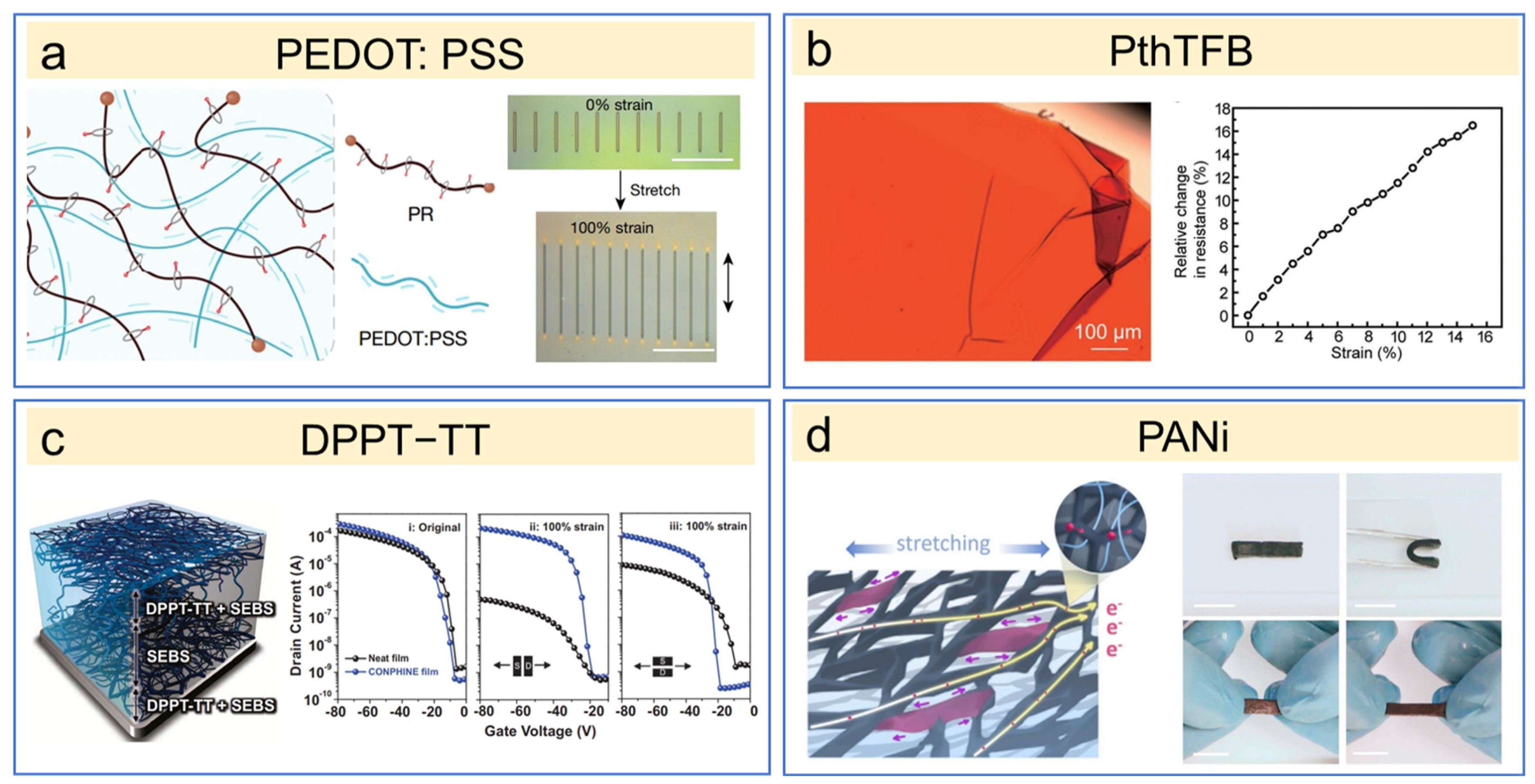

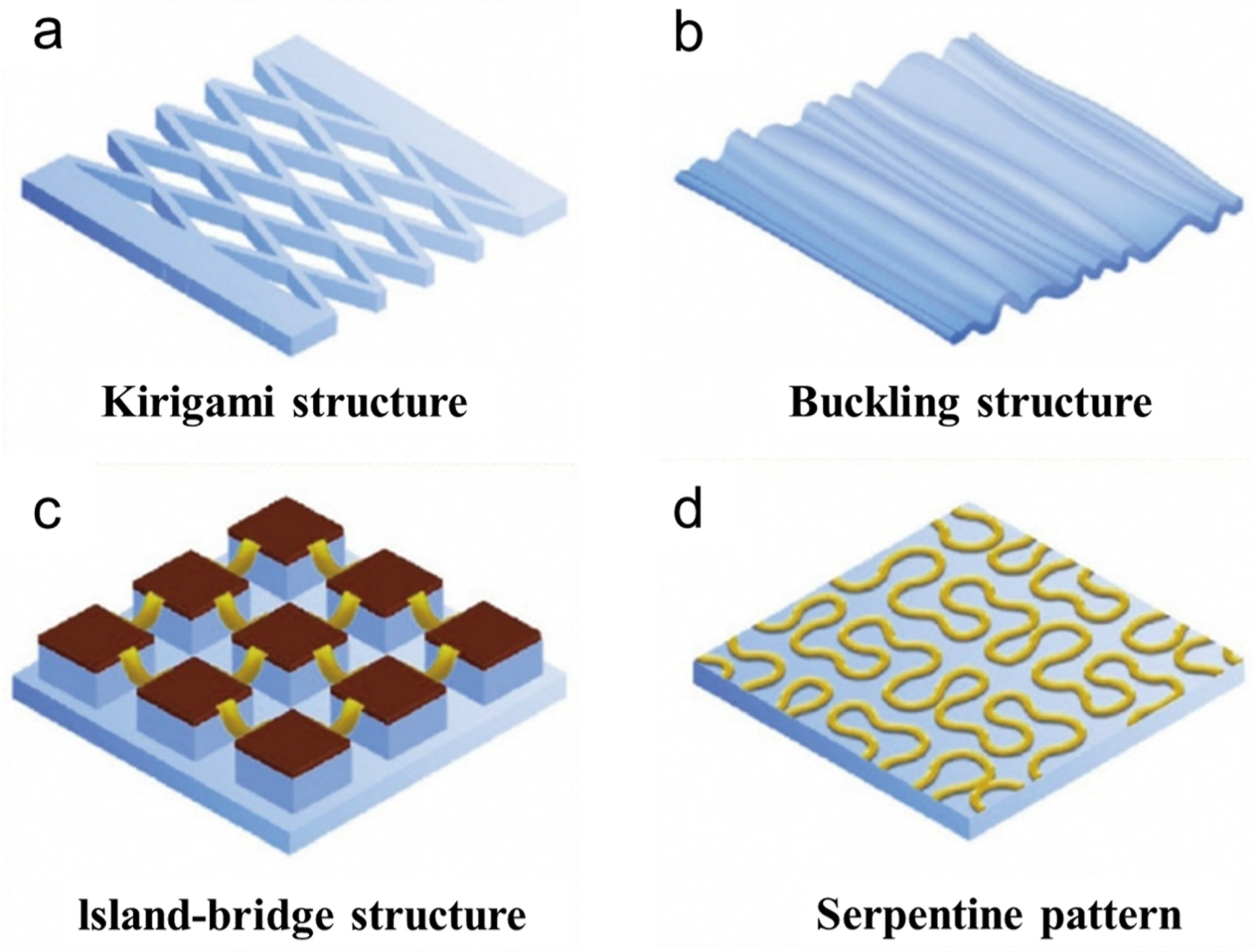
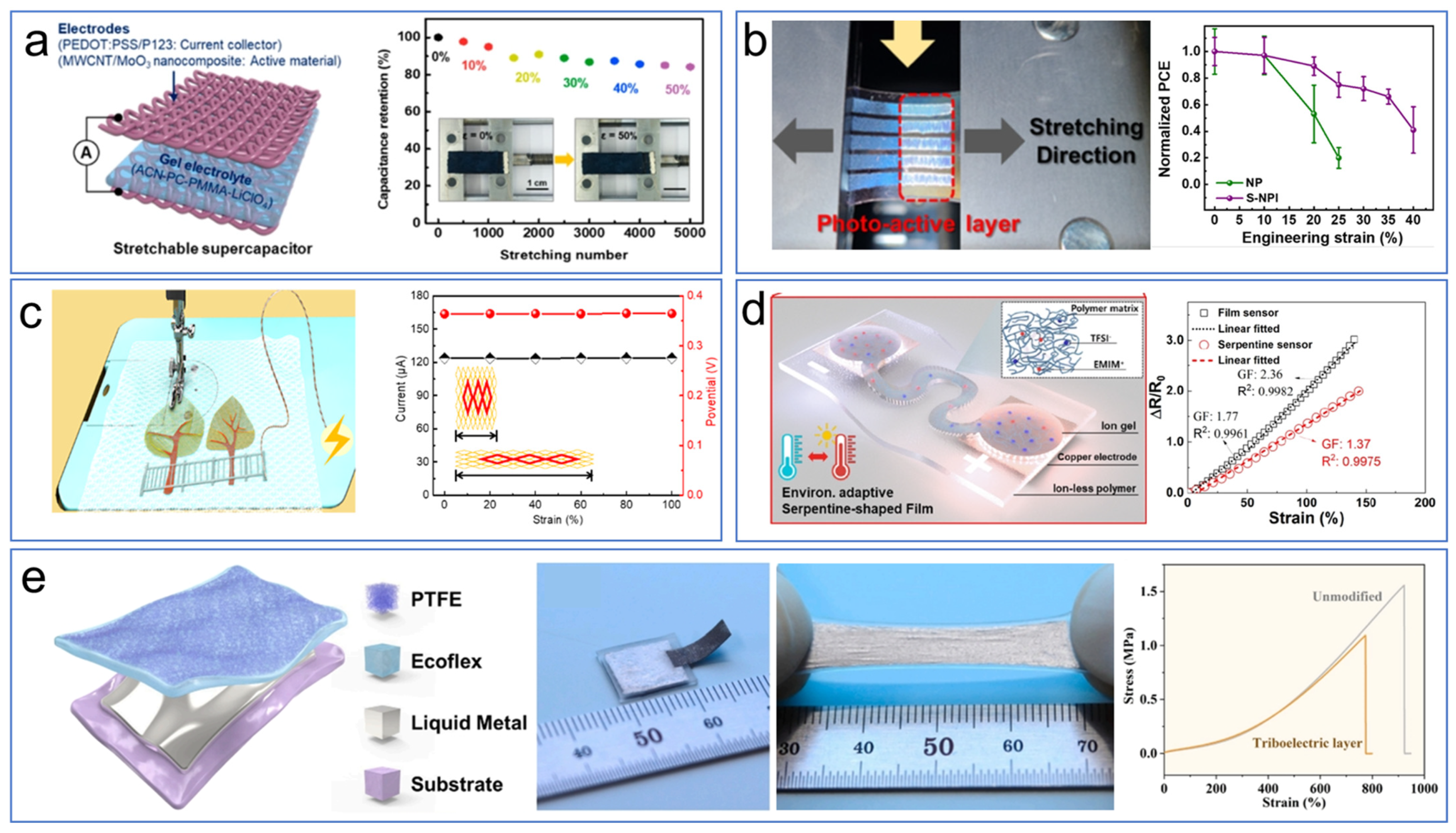
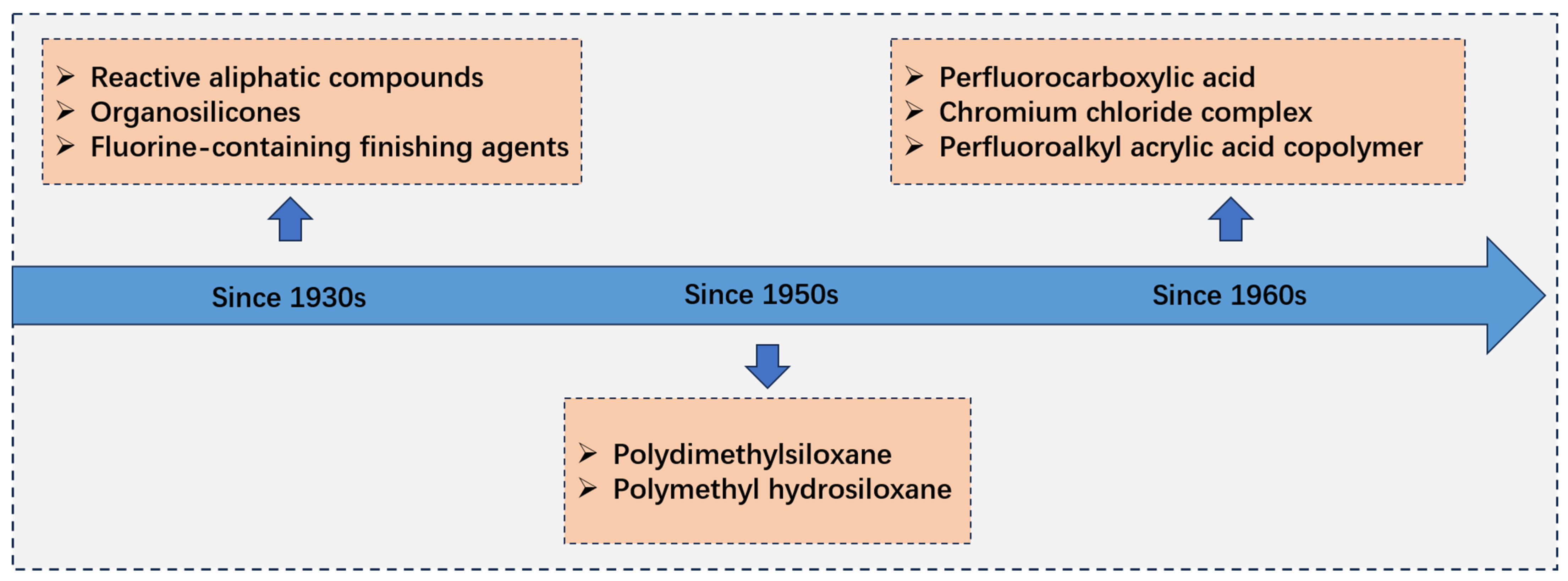
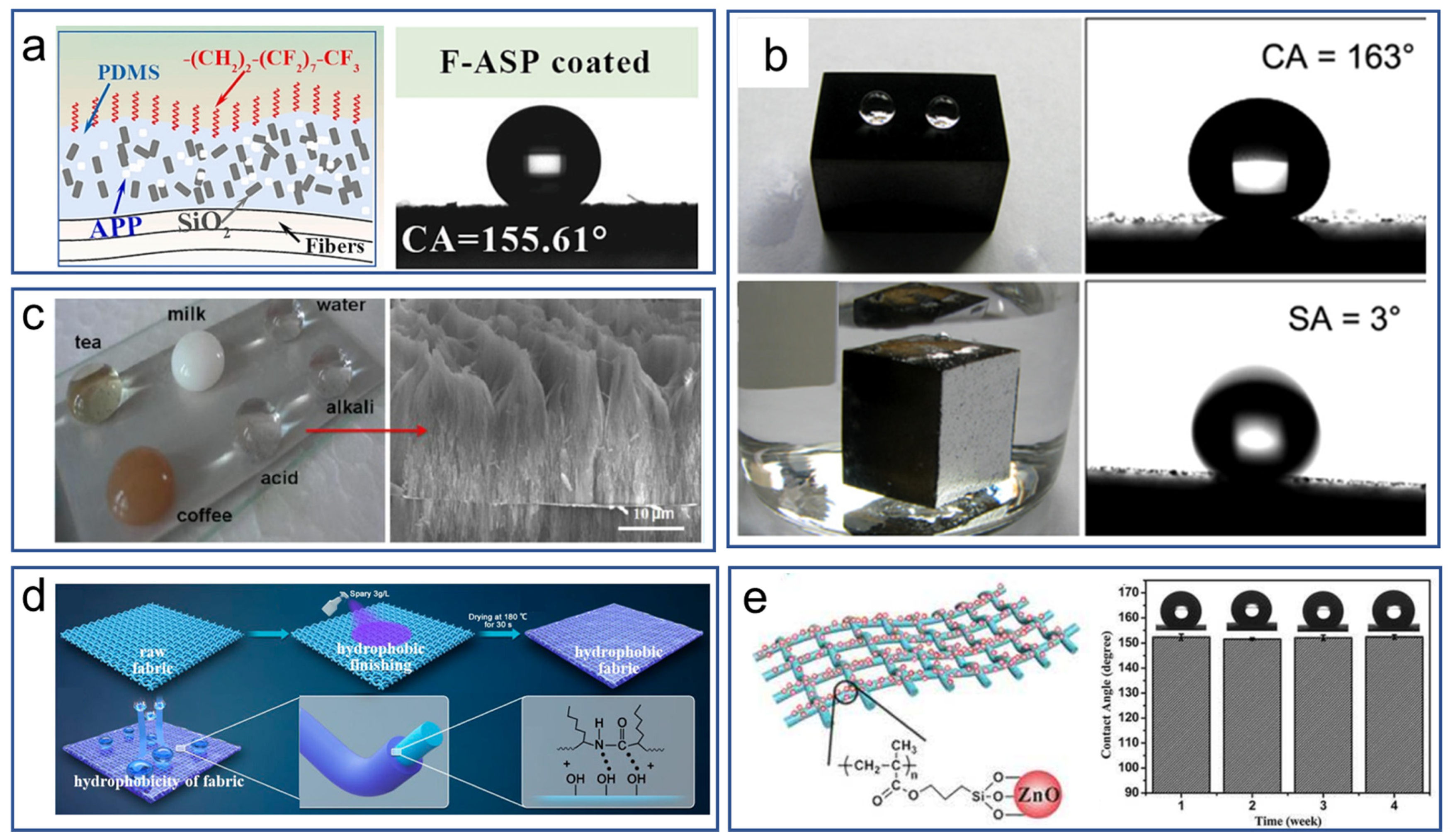
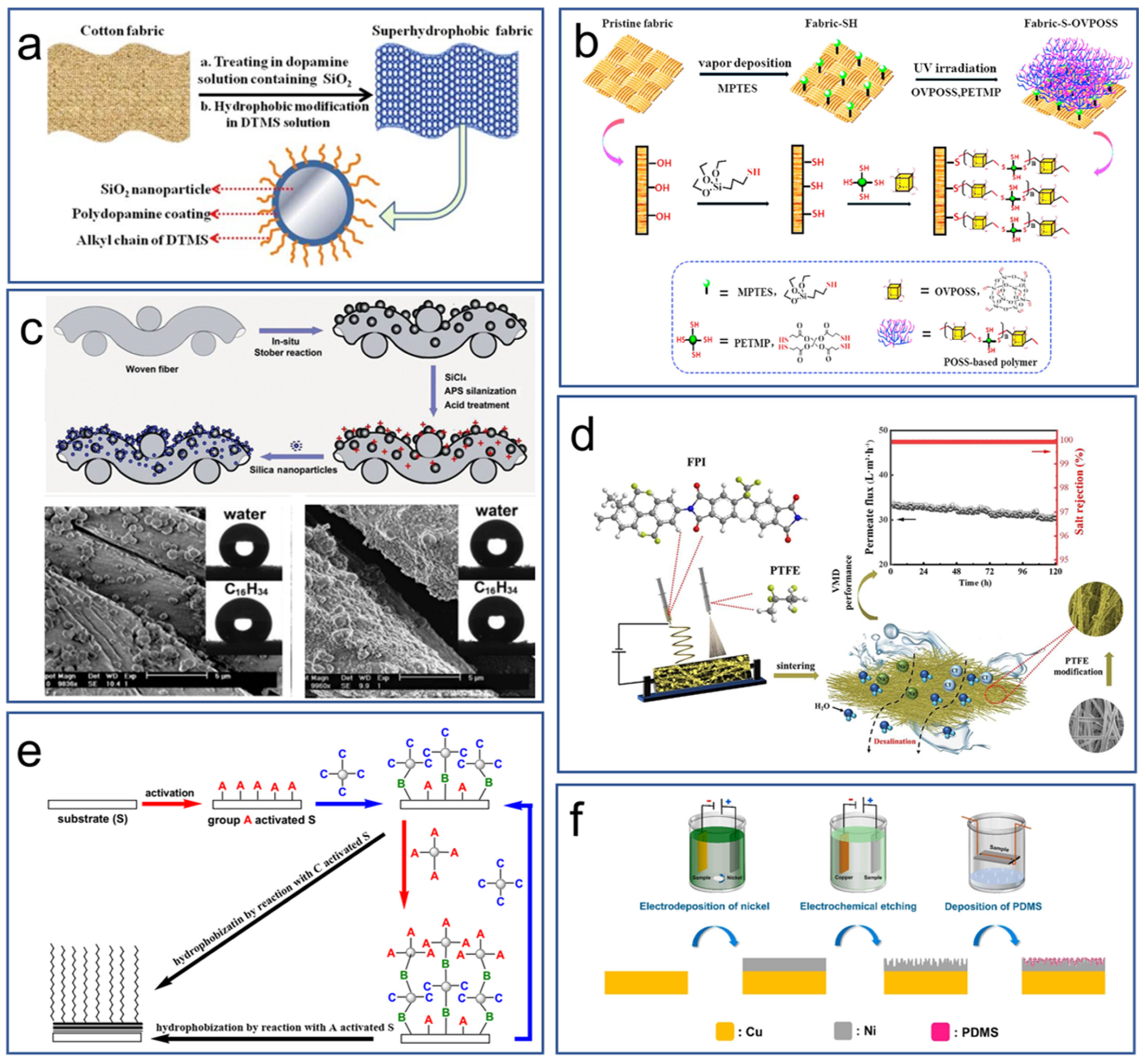
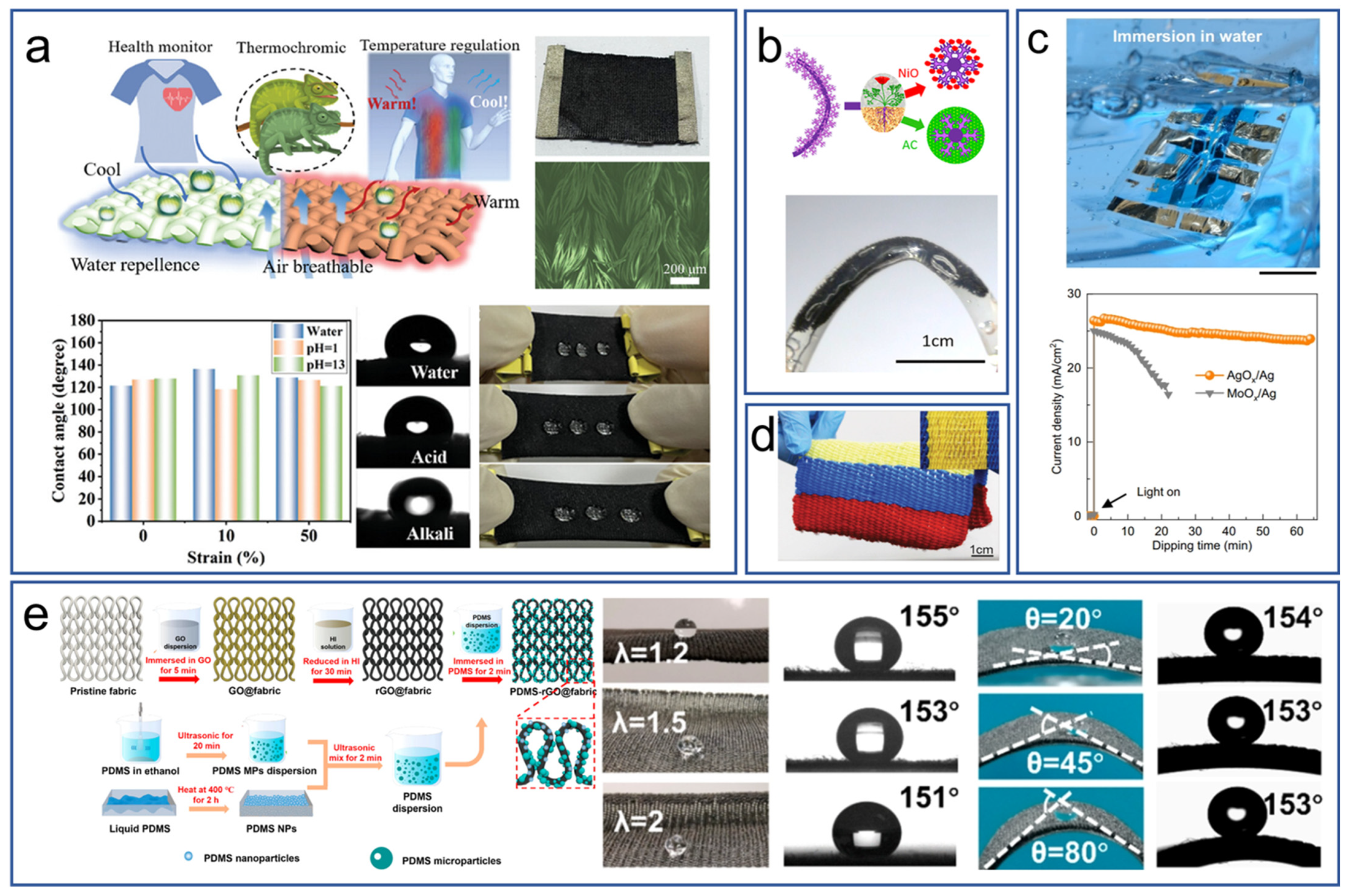
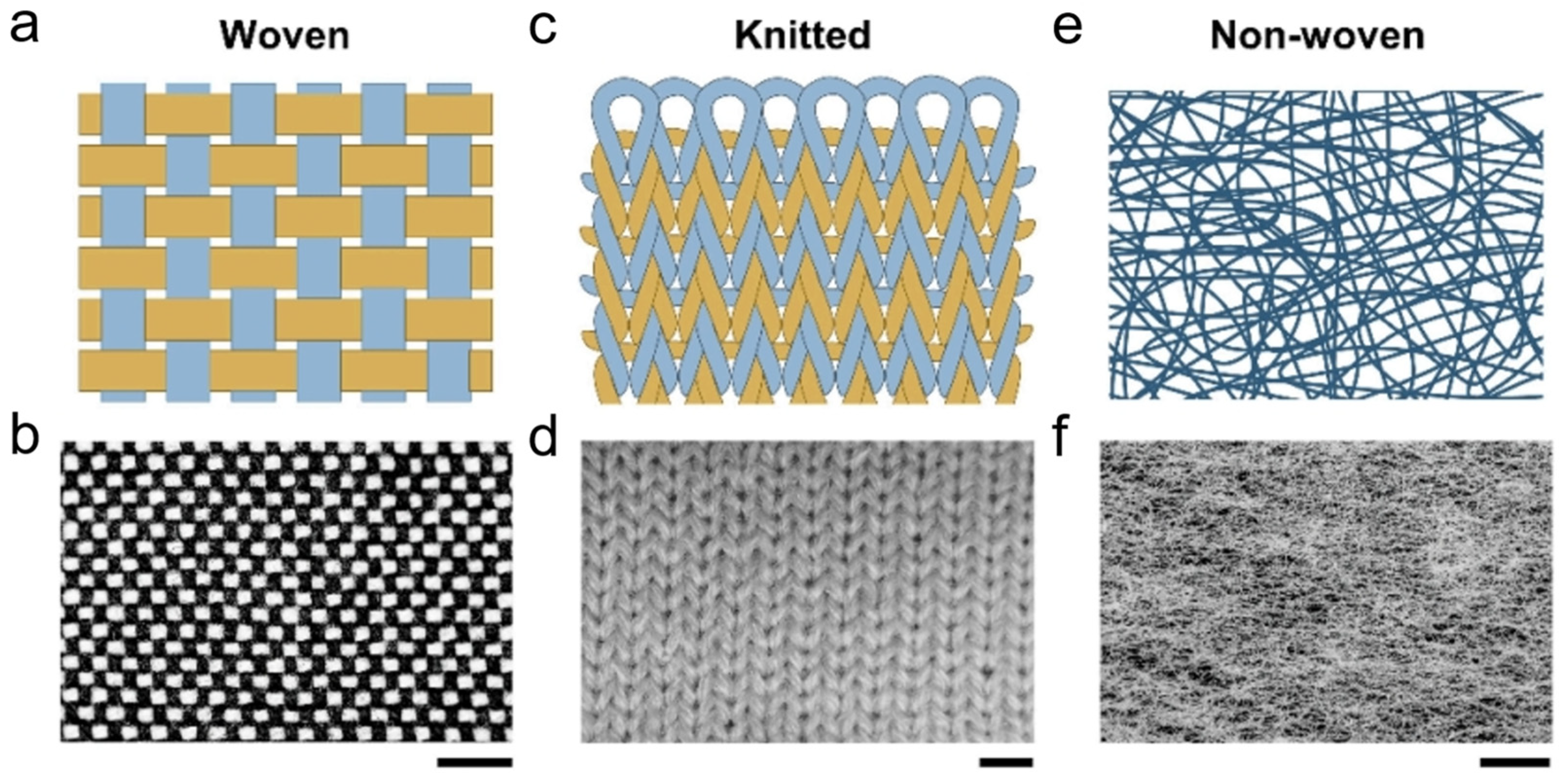
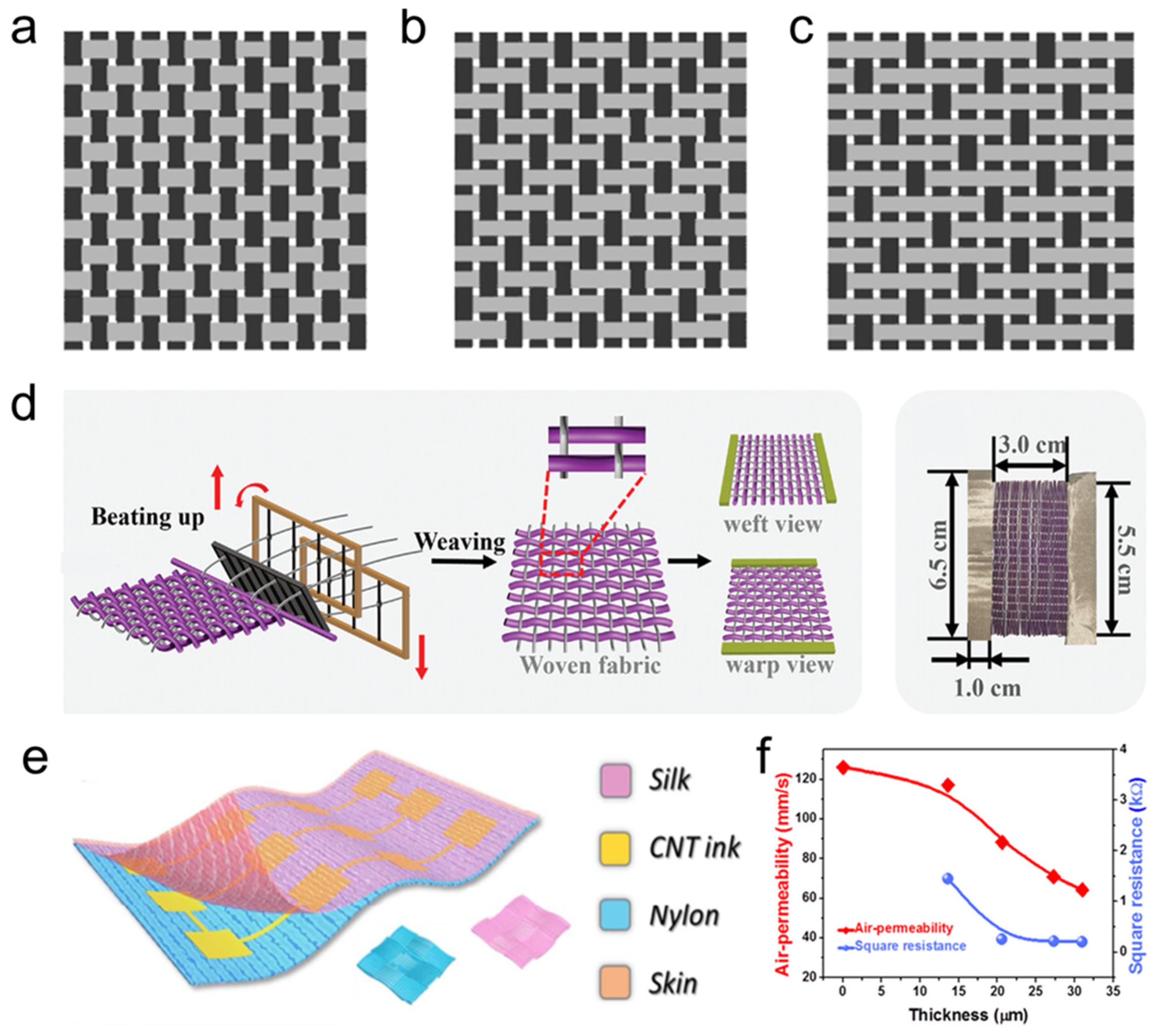
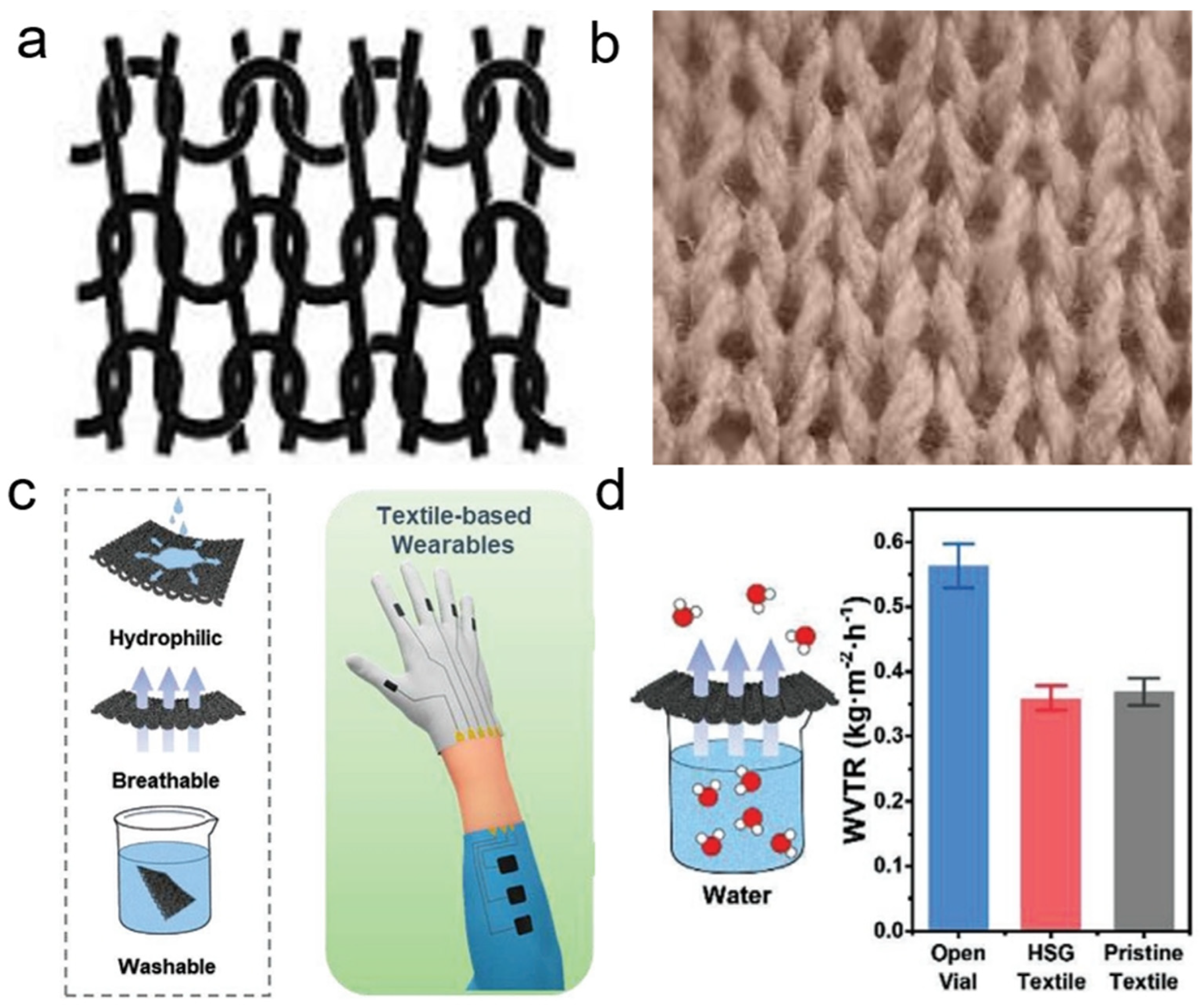

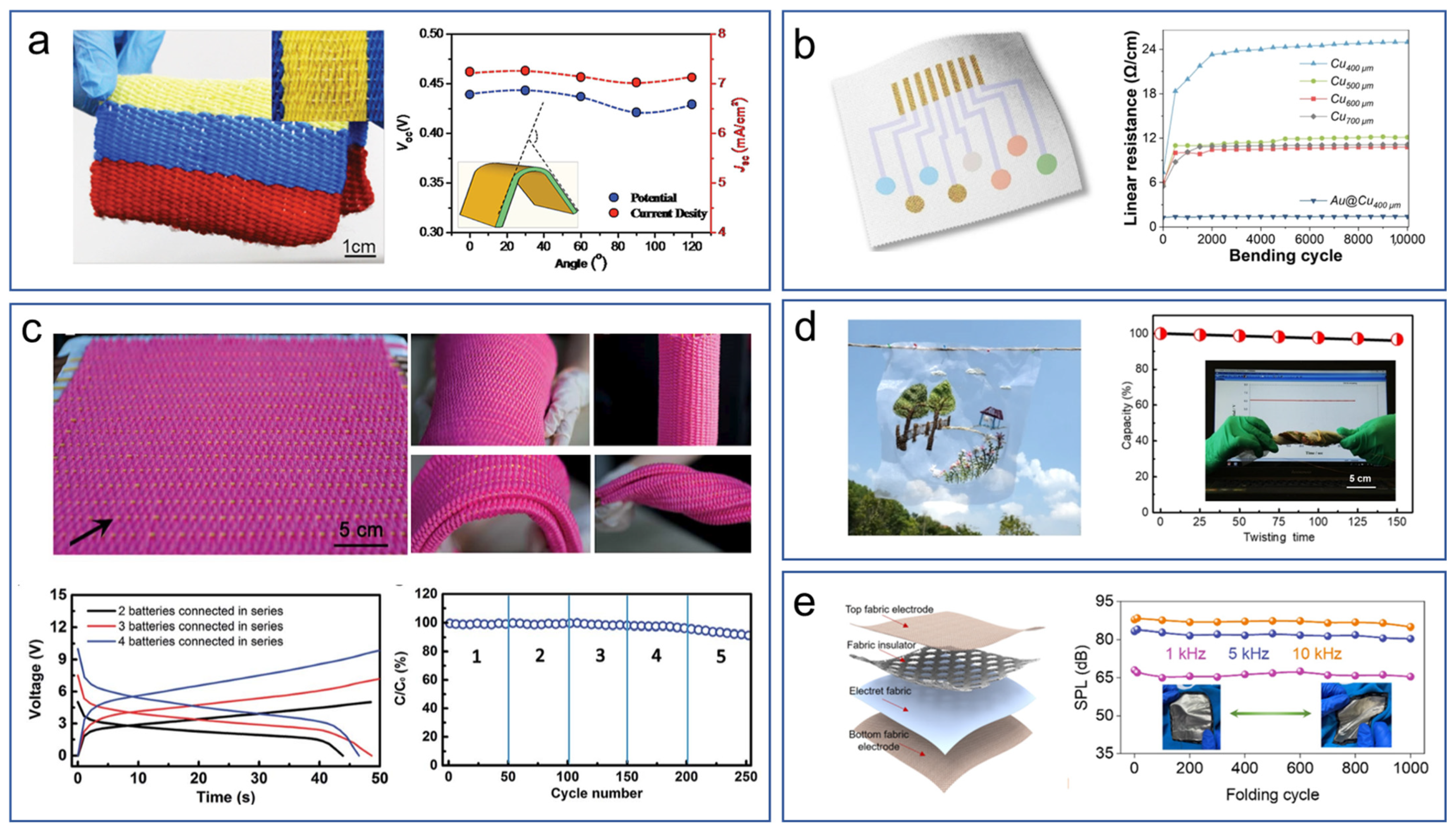
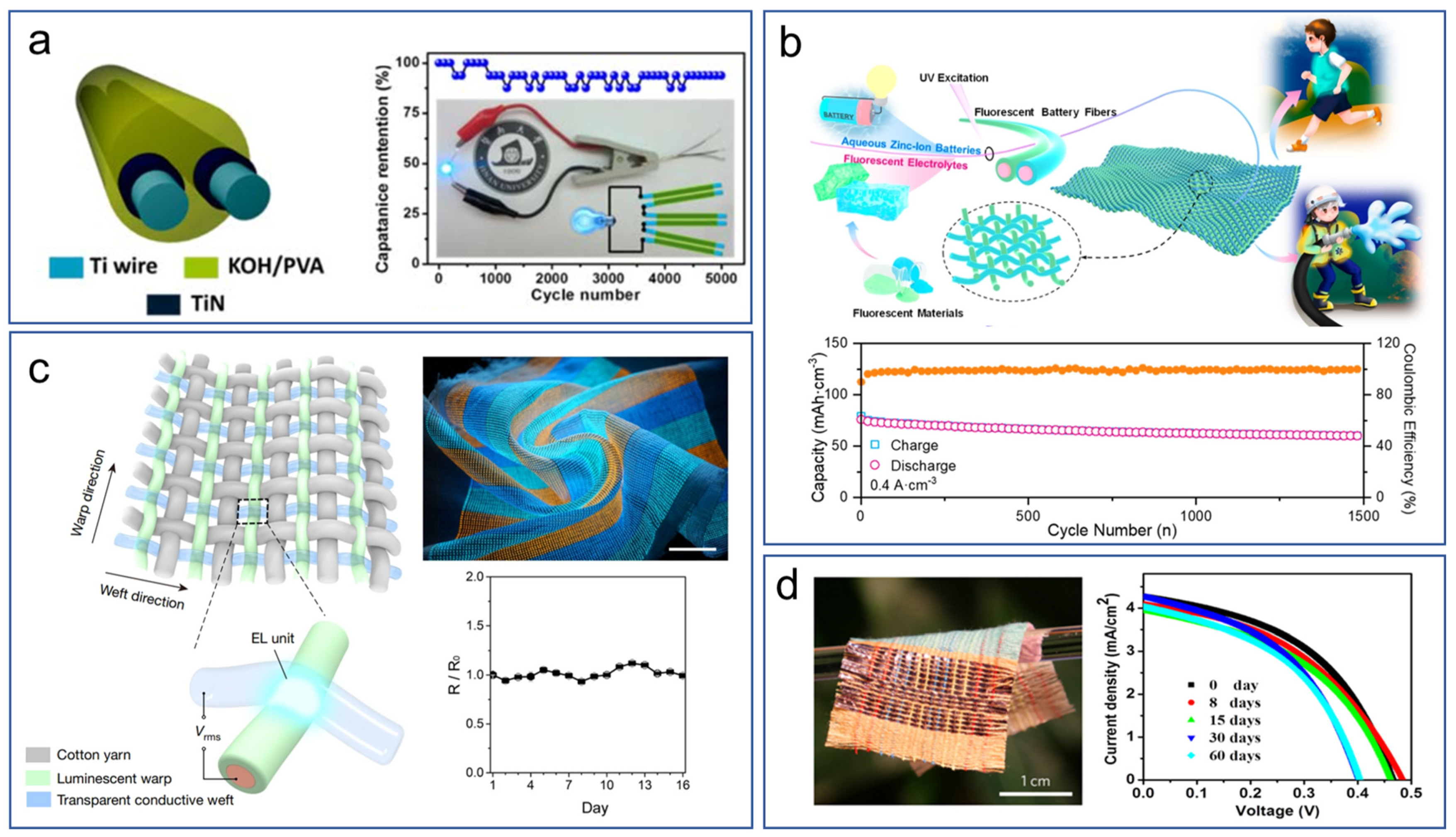

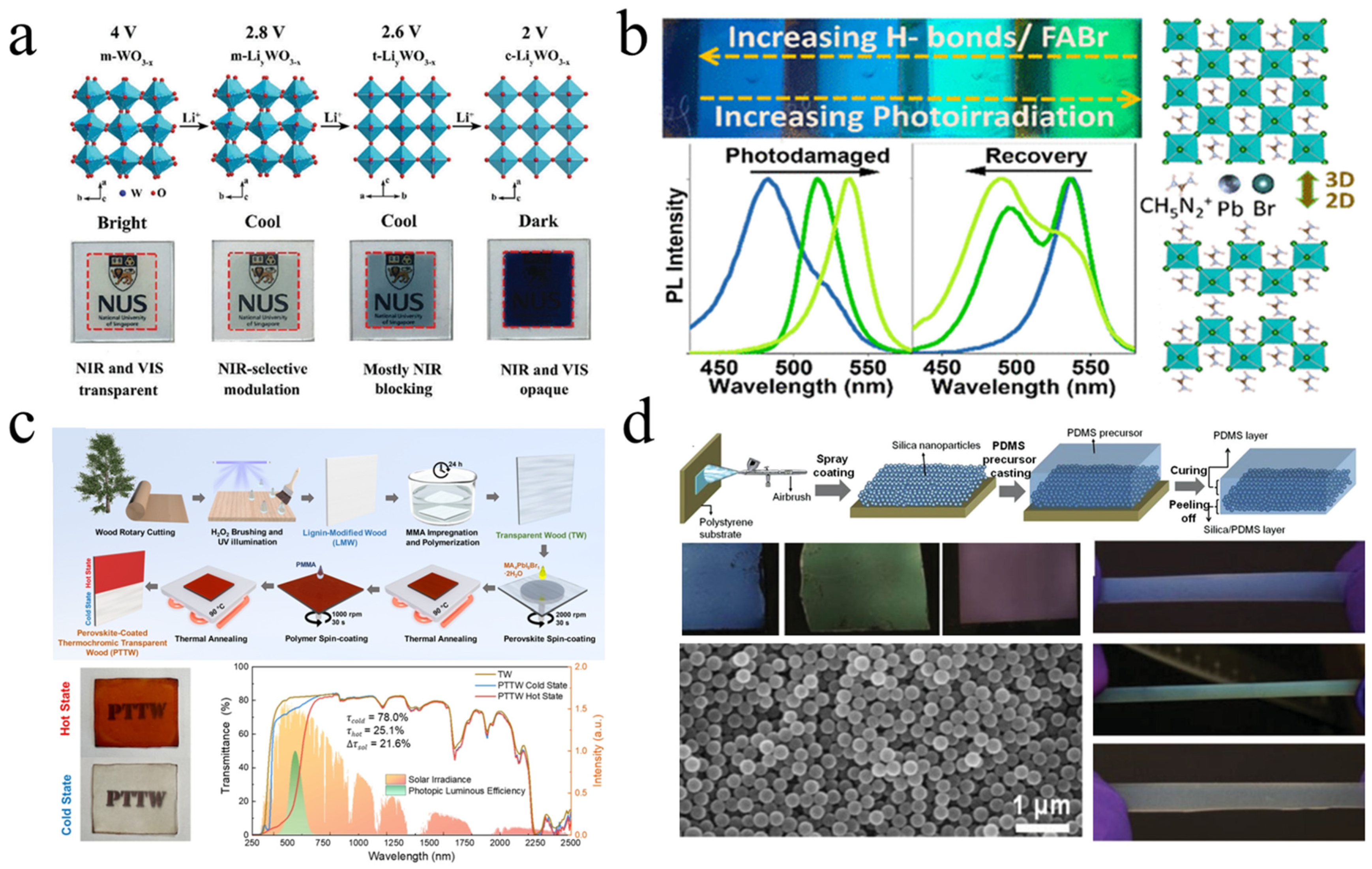
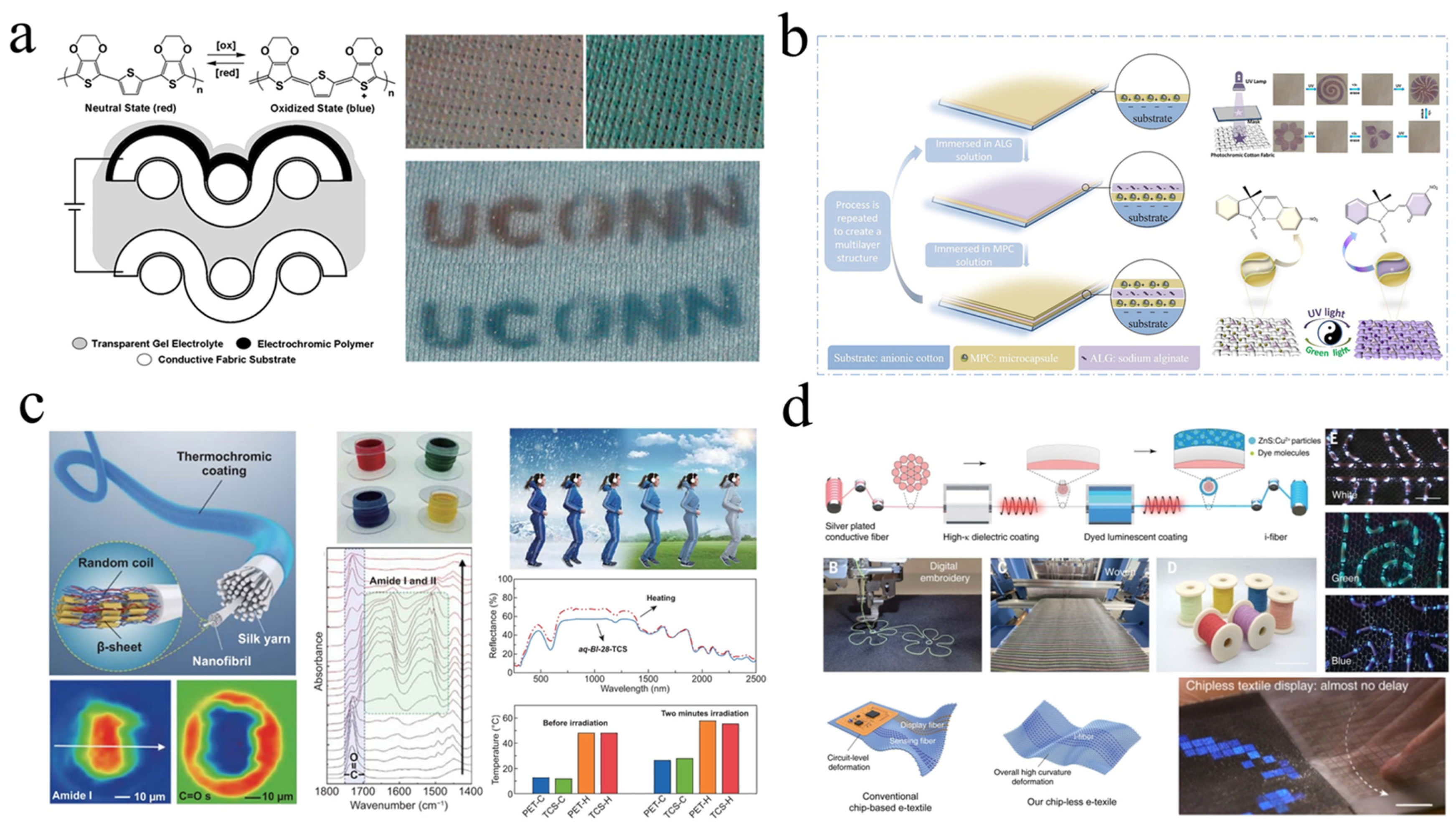
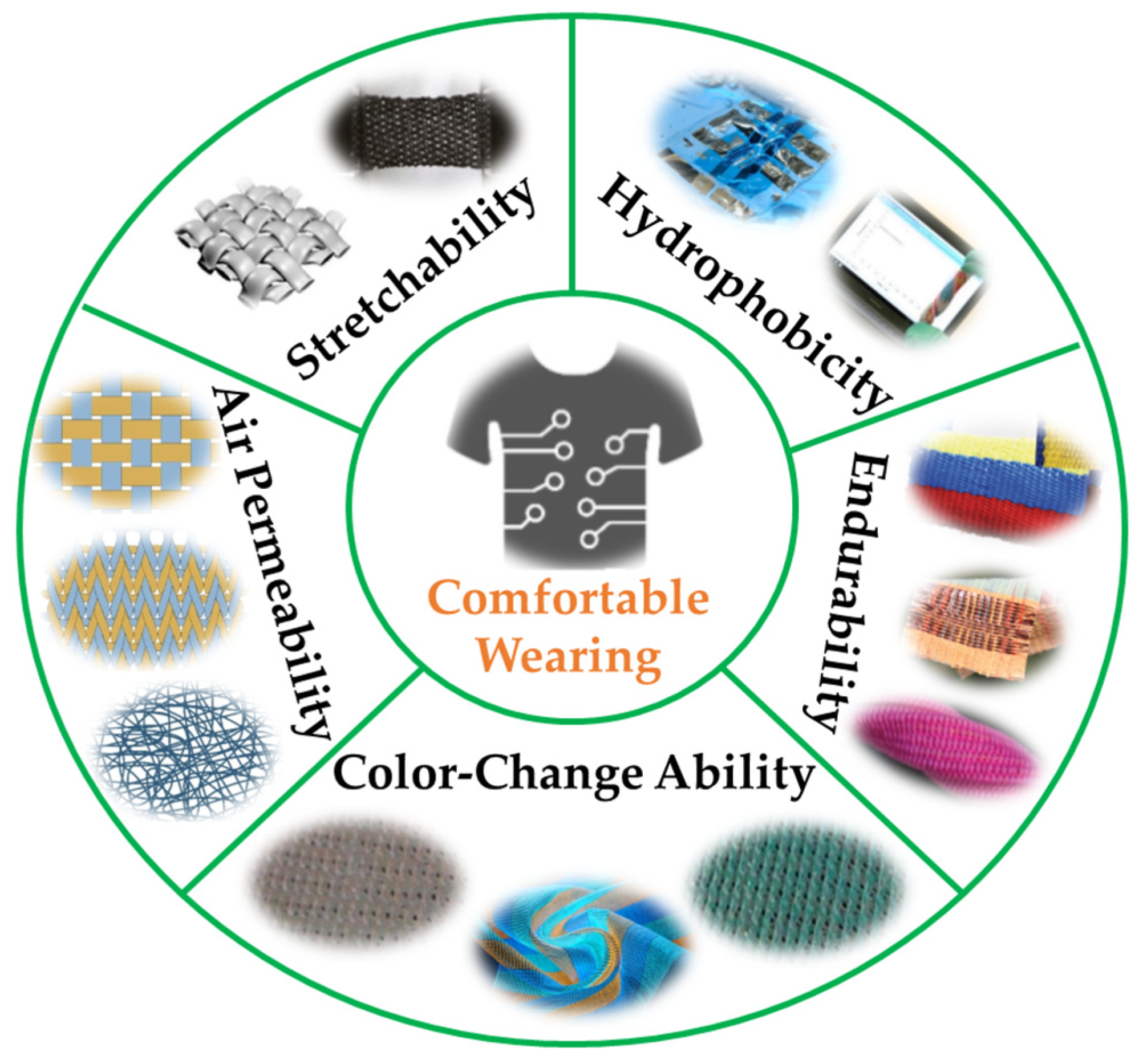
| Textile Material | Air Permeability (mm/s) |
|---|---|
| Cotton textile material | 271 |
| Hemp textile material | 535 |
| Wool textile material | 356 |
| Nylon textile material | 255 |
| Polyester textile material | 249 |
Disclaimer/Publisher’s Note: The statements, opinions and data contained in all publications are solely those of the individual author(s) and contributor(s) and not of MDPI and/or the editor(s). MDPI and/or the editor(s) disclaim responsibility for any injury to people or property resulting from any ideas, methods, instructions or products referred to in the content. |
© 2024 by the authors. Licensee MDPI, Basel, Switzerland. This article is an open access article distributed under the terms and conditions of the Creative Commons Attribution (CC BY) license (https://creativecommons.org/licenses/by/4.0/).
Share and Cite
Xiang, H.; Li, Y.; Liao, Q.; Xia, L.; Wu, X.; Zhou, H.; Li, C.; Fan, X. Recent Advances in Smart Fabric-Type Wearable Electronics toward Comfortable Wearing. Energies 2024, 17, 2627. https://doi.org/10.3390/en17112627
Xiang H, Li Y, Liao Q, Xia L, Wu X, Zhou H, Li C, Fan X. Recent Advances in Smart Fabric-Type Wearable Electronics toward Comfortable Wearing. Energies. 2024; 17(11):2627. https://doi.org/10.3390/en17112627
Chicago/Turabian StyleXiang, Hong, Yongfu Li, Qinglong Liao, Lei Xia, Xiaodong Wu, Huang Zhou, Chunmei Li, and Xing Fan. 2024. "Recent Advances in Smart Fabric-Type Wearable Electronics toward Comfortable Wearing" Energies 17, no. 11: 2627. https://doi.org/10.3390/en17112627





